Vol. 68, No. 12 (2019)
2019-06-20
GENERAL
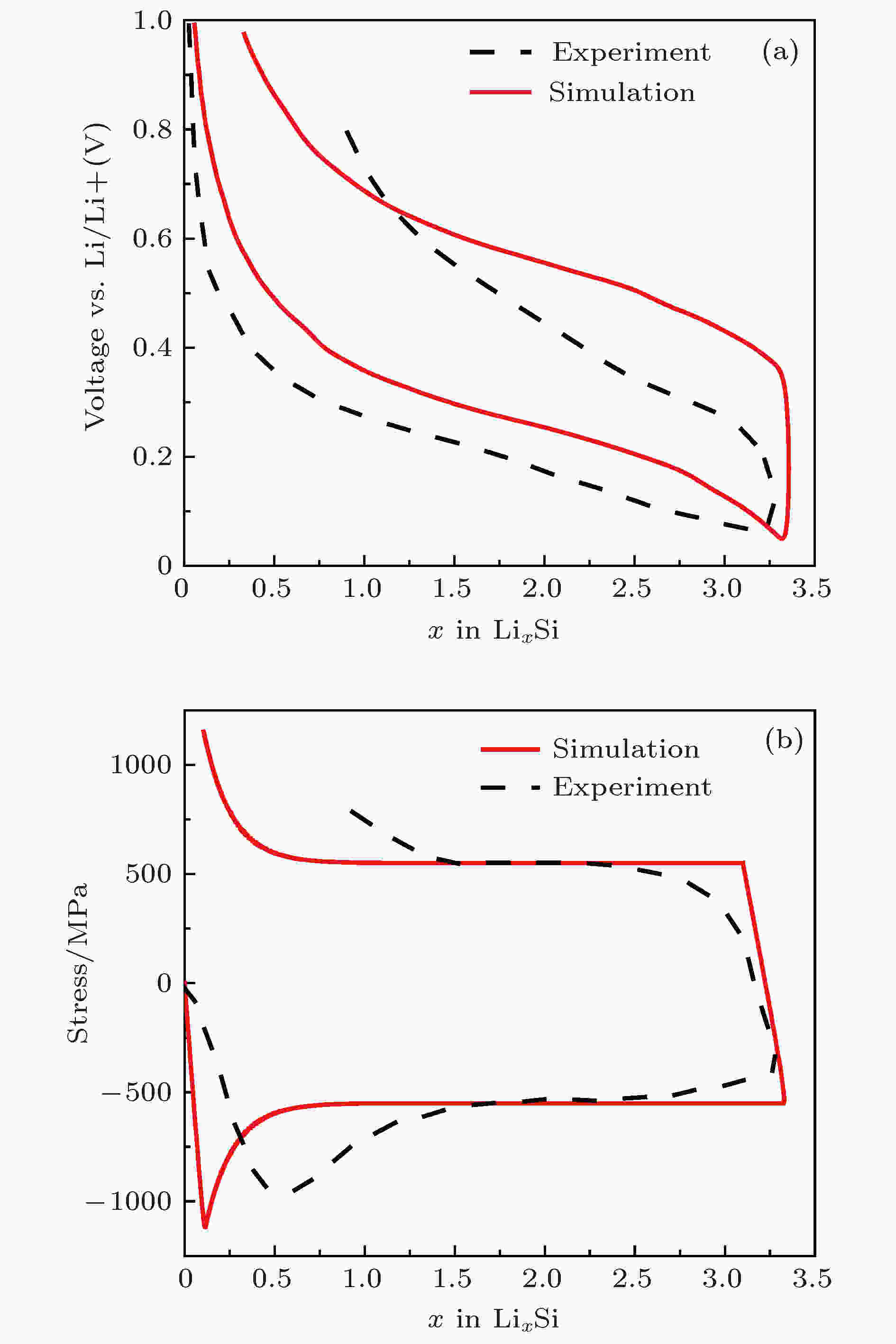
2019, 68 (12): 120201.
doi: 10.7498/aps.68.20182279
Abstract +
Electrochemical-mechanical coupling mechanism plays an important role in stress relaxation and cycle stability during charging and discharging of lithium ion batteries. The hollow core-shell structure has become a research hotspot in recent years due to the dual effects of its carbon layer and internal voids on volume expansion. However, the theory of diffusion induced stress has not been used to determine how the elastoplastic deformation of amorphous silicon affects the electrochemical performance of silicon anodes with more complex geometries. Based on the Cahn-Hilliard type of material diffusion and finite deformation, a fully coupled diffusion-deformation theory is developed to describe the electrochemical-mechanical coupling mechanism of silicon-polar particles. According to the interface reaction kinetics, the voltage response curve is obtained. The overall trend of the calculated results accords well with the experimental results, and the predicted stress response is also consistent with the experimental result, and thus verifying the effectiveness of the method. Taking the hollow carbon-coated silicon structure that has received much attention in recent years as an example, we study the electrochemical and mechanical behavior during lithiation of hollow carbon-coated silicon anodes and the capacity decay and stress evolution after charge and discharge cycles. The numerical simulation results show that the stress level of the hollow carbon-coated silicon electrode is significantly lower than that of the solid silicon electrode during the whole lithiation. With the lithiation, the stress difference becomes larger and the stress value at the end of lithiation is reduced by about 27%. It fully shows the dual effects of carbon layer and internal pores on stress relaxation and release. In addition, the concentration gradient in the solid silicon negative electrode is too large, which will result in greater stress. In contrast, the lithium ion concentration inside the hollow carbon-coated silicon particles during lithiation is significantly higher than that of the solid silicon particles, and tends to be evenly distributed, which conduces to alleviating the mechanical degradation of the electrode. At the same time, the hollow carbon coated silicon electrode reaches the fully lithiated state earlier, which fully shows the excellent electrochemical performance of the hollow core-shell structure. Finally, the numerical calculation shows that the capacity attenuation is quite consistent with the experimental measurements. Mitigation of stress levels under structural control delays the attenuation of the capacity of hollow carbon-coated silicon anodes. The excellent cycle stability can be attributed to the dual effect of carbon coating and internal pores on volume expansion and stress relief.
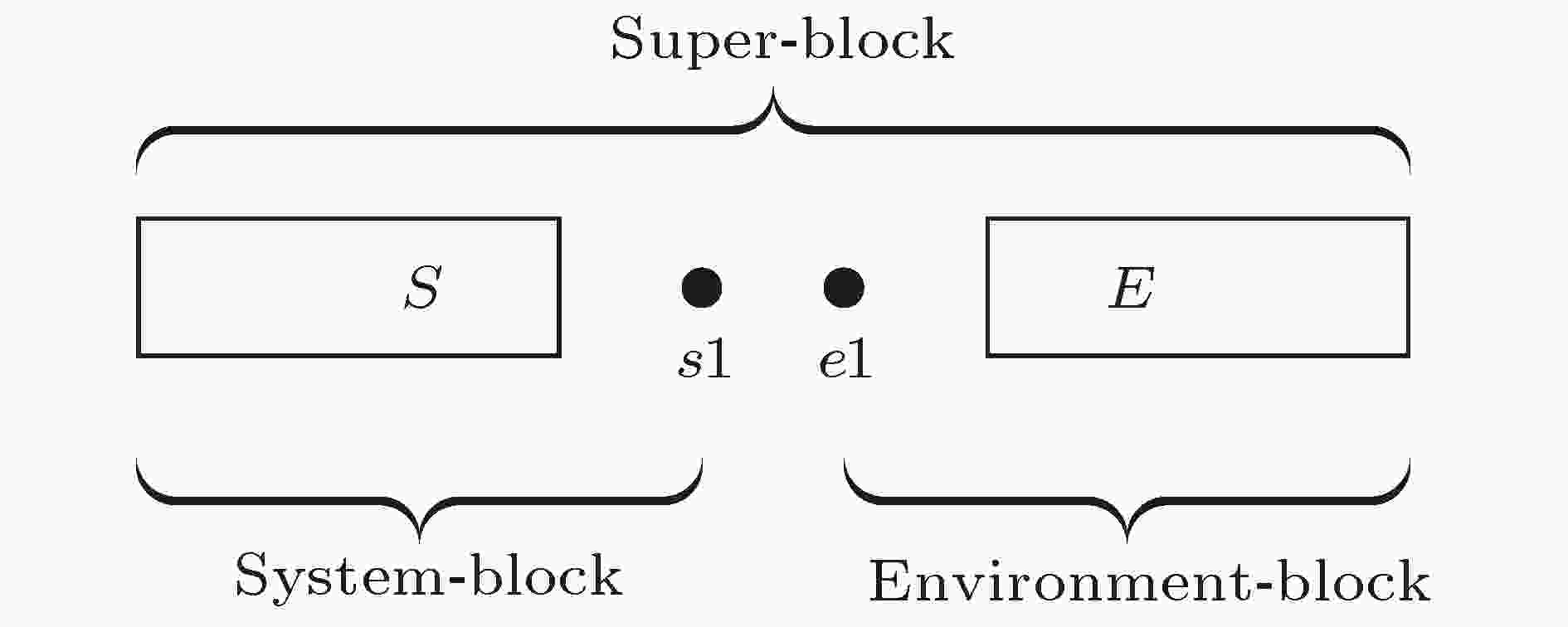
COVER ARTICLE
2019, 68 (12): 120202.
doi: 10.7498/aps.68.20190586
Abstract +
Density matrix renormalization group (DMRG), as a numerical method of solving the ground state of one-dimensional strongly-correlated lattice model with very high accuracy, requires expensive computational and memory cost when applied to two- and quasi-two-dimensional problems. The number of DMRG kept states is generally very large to achieve a reliable accuracy for these applications, which results in numerous matrix and vector operations and unbearably consuming time in the absence of the proper parallelization. However, due to its sequential nature, the parallelization of DMRG algorithm is usually not straightforward. In this work, we propose a new hybrid parallelization strategy for the DMRG method. It takes advantage of the computing capability of both central processing unit (CPU) and graphics processing unit (GPU) of the computer. In order to achieve as many as DMRG kept states within a limited GPU memory, we adopt the four-block formulation of the Hamiltonian rather than the two-block formulation. The later consumes much more memories, which has been used in another pioneer work on the hybrid parallelization of the DMRG algorithm, and only a small number of DMRG kept states are available. Our parallel strategy focuses on the diagonalization of the Hamiltonian, which is the most time-consuming part of the whole DMRG procedure. A hybrid parallelization strategy of diagonalization method is implemented, in which the required data for diagonalization are distributed on both the host and GPU memory, and the data exchange between them is negligible in our data partitioning scheme. The matrix operations are also shared on both CPU and GPU when the Hamiltonian acts on a wave function, while the distribution of these operations is determined by a load balancing strategy. Taking fermionic Hubbard model for example, we examine the running performance of the hybrid parallelization strategy with different DMRG kept states and provide corresponding performance benchmark. On a 4-leg ladder, we employ the conserved quantities with U(1) symmetry of the model and a good-quantum number based task scheduling to further reduce the GPU memory cost. We manage to obtain a moderate speedup of the hybrid parallelization for a wide range of DMRG kept states. In our example, the ground state energy with high accuracy is obtained by the extrapolation of the results, with different numbers of states kept, and we show charge stripes which are usually experimentally observed in high-temperature superconductors. In this case, we keep 104 DMRG states and the GPU memory cost is less than 12 Gigabytes.
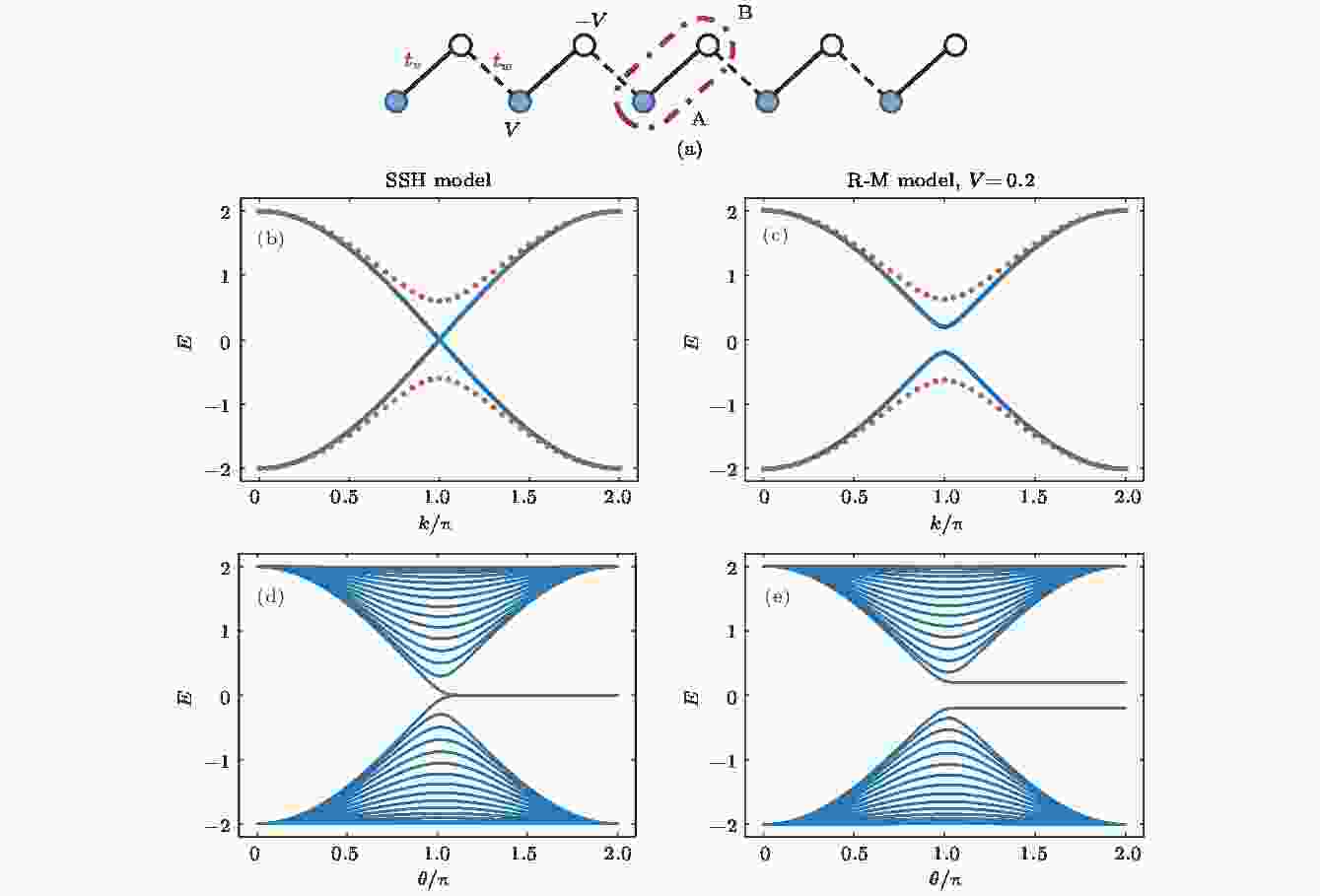
2019, 68 (12): 120301.
doi: 10.7498/aps.68.20190214
Abstract +
The existence of robust conducting edge states is one of the most prominent properties of topological insulator, which is often simply illustrated as a consequence of bulk-boundary correspondence. Then here arises a new question whether similar robust edge states appear in some other topological-trivial systems, or rather, given a general answer of fundamental mathematics such as harmonic analysis or K-theory to this problem, we study one-dimensional two-tile lattices and show that the robust edge states can exist in topological-trivial complex lattices. Under the tight-binding approximation, all kinds of one-dimensional two-tile lattices with staggered hopping matrix elements can be described by the Su-Schrieffer-Heeger model or the Rice-Mele model, depending on their site energy. The site energy values of the Su-Schrieffer-Heeger model are equal, and often assumed to be zero, and the Rice-Mele model is constructed to describe the one-dimensional two-tile lattices having two different site energy values. With the help of the generalized Bloch theorem, the eigen-state problem of electrons in one-dimensional two-tile complex lattices are solved systematically, and the analytical expressions for the wavefunctions of the edge states in the corresponding finite lattice are obtained. The numerical and analytical results show that the edge states can also emerge in any of one-dimensional two-tile lattices beyond the Su-Schrieffer-Heeger lattice, i.e., provided that the magnitude of intracell hopping is less than the intercell hopping, a pair of edge states can also emerge in Rice-Mele lattice. Unlike the Su-Schrieffer-Heeger edge states, the two Rice-Mele edge states are locally distributed at one end of the finite lattice: one at the left and another one at right. The Zak phase is a topological invariant of the Su-Schrieffer-Heeger model, but it is no longer invariant for the Rice-Mele model because of the breaking of spatial inversion symmetry, and therefore the Rice-Mele lattices are topologically trivial. However, the Rice-Mele edge states are also robust to the non-diagonal disorder of the lattice. In addition, it is proven that the winding number can provide a general criterion for the existence of a couple of edge states in any one-dimensional two-tile lattice whether it is the Su-Schrieffer-Heeger lattice or not. These results lead to a conclusion that the topological invariant is not necessary for the robust edge states to occur.
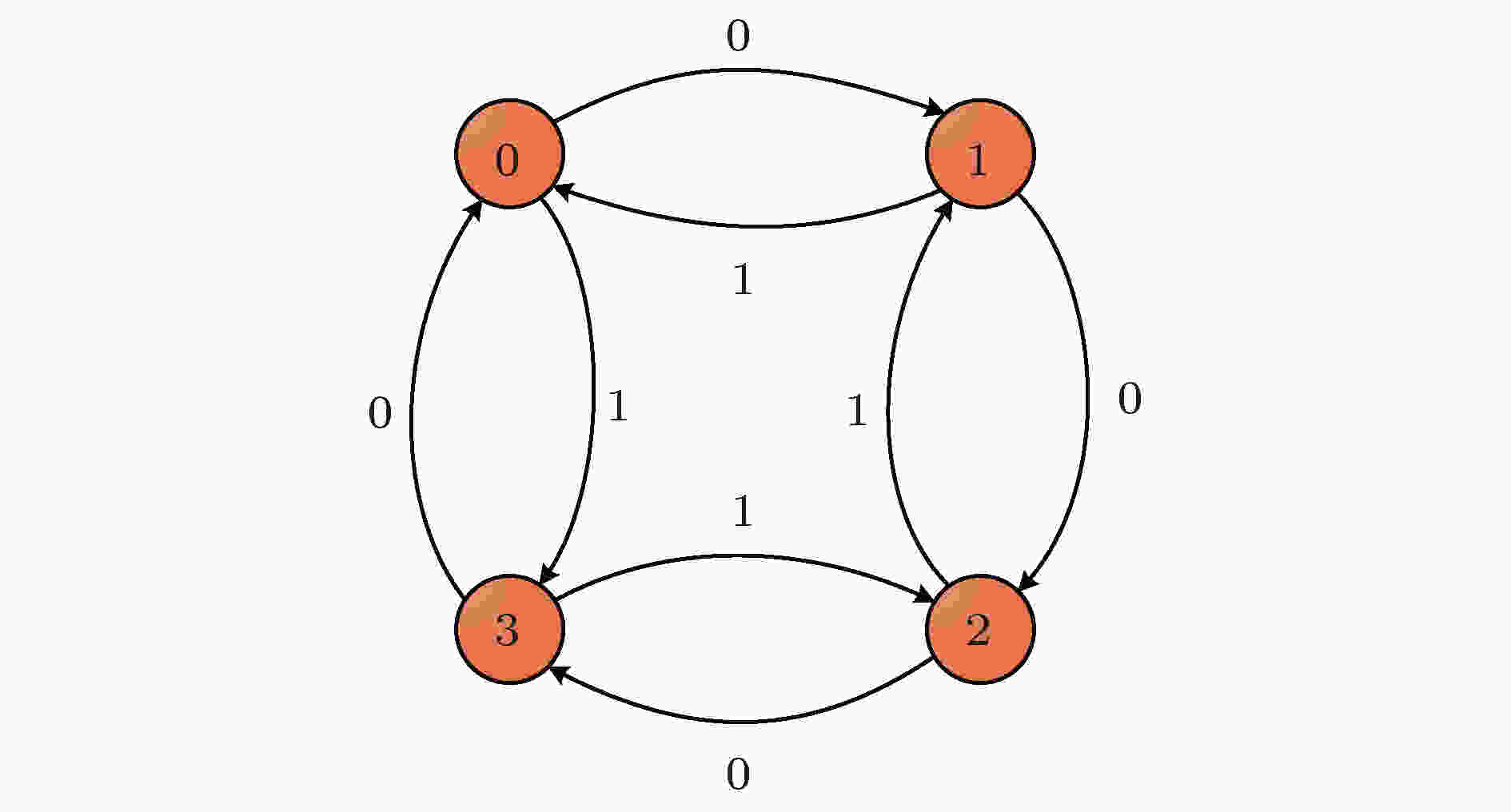
2019, 68 (12): 120302.
doi: 10.7498/aps.68.20190274
Abstract +
2019, 68 (12): 120401.
doi: 10.7498/aps.68.20182260
Abstract +
The spin-orbit interaction and spin Hall effect have drawn special attention. Not only theoretical predictions have been made, but also the generation of spin currents has been achieved in experiment. In this paper, we study the spin current and the spin Hall conductivity under the influence of rotation in the curved space-time. Our work shows that the nontrivial geometries could modify the spin-orbital interaction. By using the extended Drude model, we calculate the spin-dependent force and obtain a correction to this force by non-mediocre geometry. When considering the rotation effect, the general Dirac equation is given. The Hamiltonian under the non-relativistic approximation is obtained by the Foldy-Wouthuysen transform. According to this, we calculate the spin current and spin Hall conductance. The polarization vector is deformed due to the effect of the rotation in the curved space-time. The magnitude and direction of the spin current are changed because of the correction to rotation, and the spin Hall conductivity. The nontrivial space-time geometry leads to the anisotropic nature of the spin current. Our work uses a general method that does not depend on the model, so the result can be used to analyze the electromagnetic dynamics of charged spin particles in quantum Hall systems, and it also helps to theoretically study the defects in crystals. Our results can also be extended to the optical subsystem. Considering the spin effect of photons, based on the spin-orbit coupling of photon, a light splitting phenomenon emerges in an inhomogeneous medium, which is the spin hall effect of photon. Our discussion has a certain reference value for studying the behavior of the photonic spin Hall effect in the static gravitational field. At the same time, using the optical chips to simulate curved space-time, photon manipulation and precision measurement can give some theoretical support.
INVITED REVIEW

EDITOR'S SUGGESTION
2019, 68 (12): 120701.
doi: 10.7498/aps.68.20190281
Abstract +
Modern infrared detector technology has a history of nearly eighty years. Since the first PbS photodiode was put into use during the World War II, infrared detectors have achieved significant progress, even the third-generation infrared systems have been proposed. In the past decades, the traditional infrared detectors represented by HgCdTe, InSb and InGaAs have been widely applied in military, remote sensing, communication, bioscience, and space exploration. However, the increasing applications demand higher performance infrared detectors. Especially in recent years, the intelligent infrared detection technique was strongly demanded in many high-tech fields such as artificial intelligence, virtual reality systems and smart city. Therefore, the fabricating of infrared detection systems with smaller size, lighter weight, lower power, higher performance and lower price has become an urgent task. At present, the infrared photodetectors are in an age of rapid change, and many new type of advanced infrared photodetectors come to the fore quickly. For the purpose of summarizing these detectors, they are reviewed covering four parts: microstructure coupled infrared detector, infrared detector based on band engineering, new type of low-dimensional material infrared detector, and new directions for traditional infrared detectors. In the infrared detection systems, these photodetectors can be fully used for their prominent performance. The microstructure coupled infrared detector can improve chip integration with high quantum efficiency. Precise design of band structure will raise the operating temperature for mid and long wavelenth infrared photodetectors. Owing to the unique structures and physical properties, low-dimensional material infrared photodetectors have shown their potential application value in flexibility and room temperature detection systems. The ability of avalanche photodetector to detect the extremely weak signal makes it possible using in the frontier science such as quantum private communication and three-dimensional radar imaging systems. The device based on hot electron effect provides a new idea for far infrared detection. The barrier detectors will reduce the manufacturing cost of traditional materials and the design is also very illuminating for other new materials. In this review, firstly we present the history of infrared photodetectors in short. Then the mechanism and achievements of the advanced infrared photodetectors are introduced in detail. Finally, the opportunities and challenges of infrared detection are summarized and predicted.
NUCLEAR PHYSICS
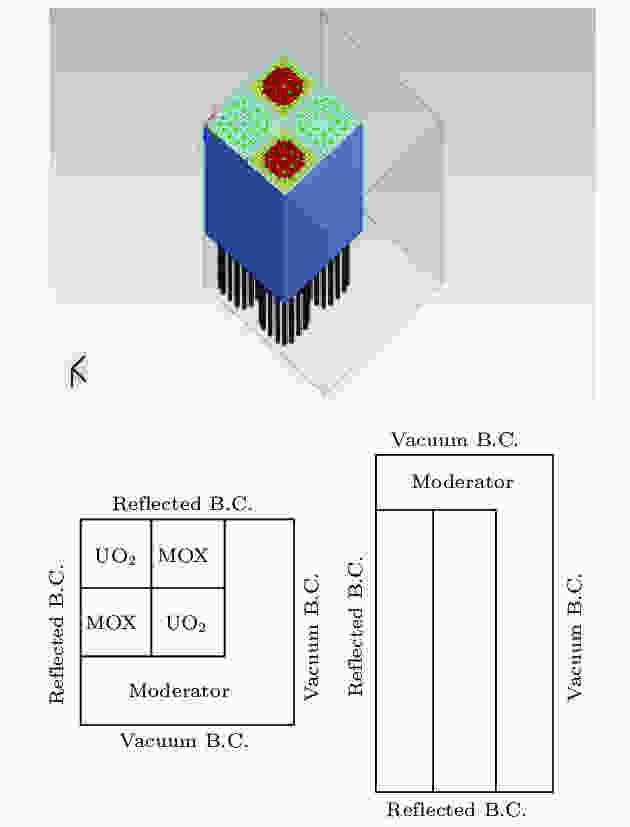
2019, 68 (12): 122801.
doi: 10.7498/aps.68.20182276
Abstract +
Traditionally, the Monte Carlo criticality calculation must set a maximum inactive step by experience to ensure that a fission source distribution has converged. The tallying process can only be invoked after this maximum inactive step to avoid the system error caused by the non-converged fission source distribution. In the same way, the uniform fission site algorithm for increasing the whole efficiency of global tallying should also be invoked after the fission source distribution has converged fully. The calculation must reach a maximum iteration step, then, this process can be stopped and the tallies can be printed. This old strategy has two defects. Firstly, the appointed maximum inactive step can only be set by experience, which will be insufficient in some cases; secondly, some iteration steps can be wasted because the precision of tallies has been enough and no one knows it. So, a new strategy is proposed in this article to overcome these defects. Based on an on-the-fly diagnostic method for the convergence of Shannon entropy sequence corresponding to the fission source distribution of each iteration step, the uniform fission site algorithm will be invoked after the iteration step whose serial number is the maximum of the first active step and the first converged step diagnosed by the above-mentioned rule. This rule will be helpful in ensuring that the uniform fission site algorithm can use enough accurate data to bias the secondary fission neutron number, thus avoiding the system error to some degree. Then, a global precision index will be calculated at each fixed step to judge whether the precision standard is reached. If so, the whole calculation is stopped. This process will be repeated until the pre-set maximum step number is reached. In this way, superfluous calculations can be skipped but the calculation precision can be guaranteed. In a word, this new strategy is beneficial to increasing the efficiency of global tallying in the Monte Carlo criticality calculation when appropriate parameters are adopted. This conclusion can be proved by the numerical result from the C5G7 benchmark model.
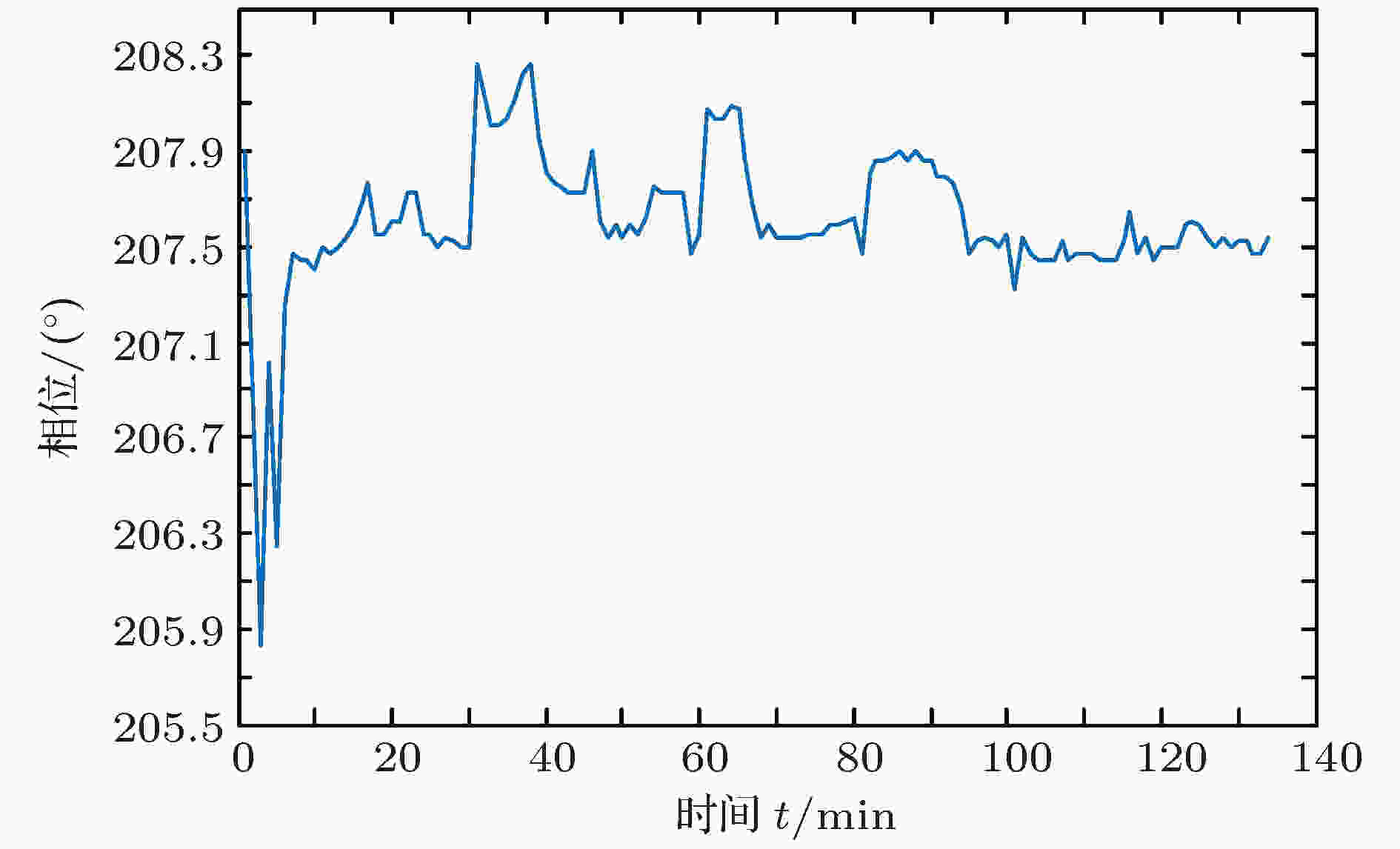
2019, 68 (12): 122901.
doi: 10.7498/aps.68.20190116
Abstract +
The high-frequency resonant cavity is affected by factors such as beam load, gravity and heat loss caused by cavity deformation during the actual operation of the medical cyclotron. The resonant frequency will shift to a certain extent, resulting in the high-frequency operation frequency varying with the resonant frequency of the resonator cavity. In order to meet the requirements for isochronous acceleration, the magnetic field strength should also be changed correspondingly when the high-frequency operation frequency changes, that is, the magnitude of the magnet current needs changing accordingly, so that the particle cyclotron frequency matches the high-frequency resonant frequency to overcome the sliding phase. Firstly, the static magnetic field model is established by finite element simulation software to simulate the average magnetic field of cyclotron under different magnet currents. Then the relationship between the magnetic field and the resonant frequency is theoretically analyzed. Finally, the relationship between the magnet current and the resonant frequency is obtained when the magnet current varies in a small interval. According to the optimal magnet current corresponding to different resonance frequencies, the automatic frequency tracking of magnet current is completed. In the case of ensuring the maximum carbon film beam, the optimal magnet current corresponding to different resonance frequencies is obtained, which makes the theory validated. According to the relationship, the magnet current is automatically adjusted, which overcomes the slip phase and ensures the stable output of the Faraday beam. The method enables the magnet current to be quickly and accurately find and track the cavity frequency, overcomes the slip phase caused by the frequency offset, and completes the stable output of the beam.
ELECTROMAGNETISM, OPTICS, ACOUSTICS, HEAT TRANSFER, CLASSICAL MECHANICS, AND FLUID DYNAMICS
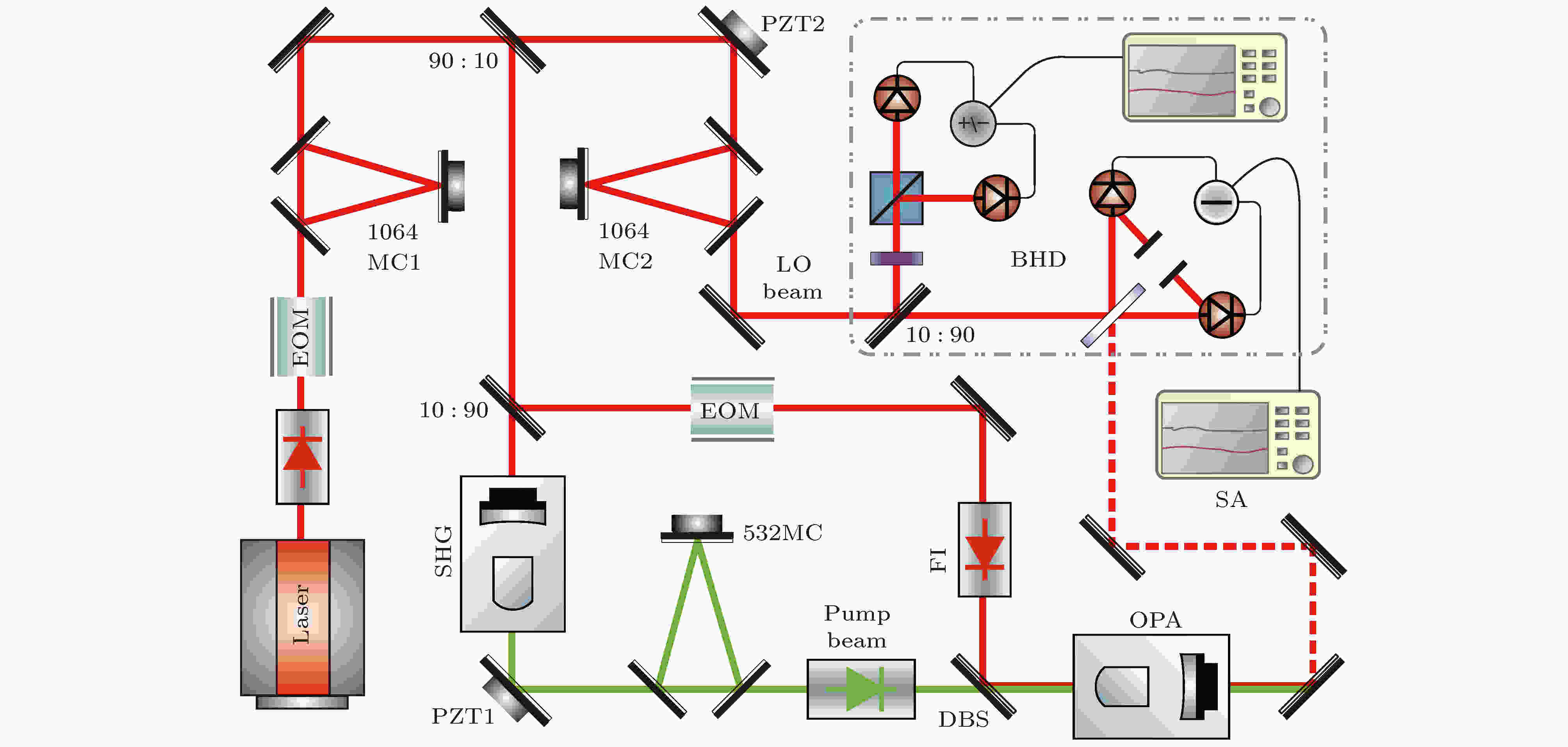
EDITOR'S SUGGESTION
2019, 68 (12): 124201.
doi: 10.7498/aps.68.20182304
Abstract +
Squeezed states, which have fewer fluctuations in one quadrature than vacuum noise at the expense of increasing fluctuations in the other quadrature, can be used to enhance measurement accuracy, increase detection sensitivity, and improve fault tolerance performance for quantum information and quantum computation. In this paper, the influences of relative intensity noise (RIN) of all-solid-state single-frequency laser and single-frequency fiber laser on the squeezing factor of squeezed vacuum states are experimentally and theoretically studied. Here, an all-solid-state single-frequency laser and a single-frequency fiber laser each are used as a light source of the system generating squeezed vacuum states. The homodyne detection is used to compare the RIN of all-solid-state single-frequency laser and that of single-frequency fiber laser at the analysis frequency of 1 MHz. The results show that the RIN of the all-solid-state single-frequency laser and single-frequency fiber laser are higher than those of the shot noise limitation 2.3 dB and 30 dB at the analysis frequency of 1 MHz, respectively. The RIN of all-solid-state single-frequency laser is far less than that of the single-frequency fiber laser. As a result, squeezed vacuum state with maximum quantum noise reduction of (13.2 ± 0.2) dB and (10 ± 0.2) dB are directly detected. Theoretical calculation shows that the influence of the RIN on the measurement accuracy is the major factor of degrading the squeezing factor with the fiber laser as the pump source. The measurement error of squeezed vacuum state caused by the RIN of single-frequency fiber laser is about 2.6 dB. The discrepancy of the pump power between the two lasers is another factor of affecting the squeezing factor, corresponding to 0.6 dB quantum noise difference. The theoretical calculations are consistent with the experimental results, which provides some guidance for developing the practical squeezed states with highly squeezing level.
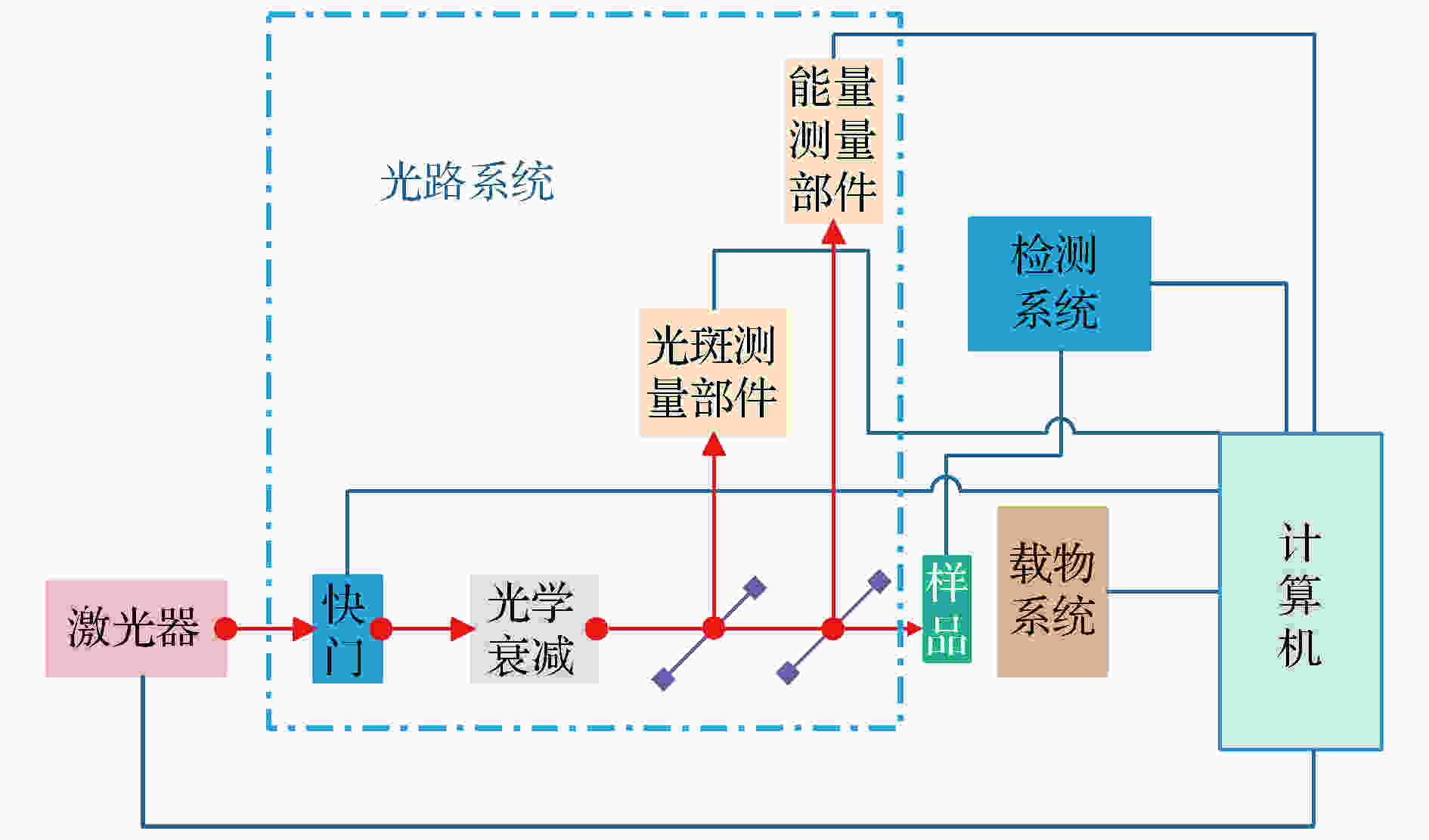
2019, 68 (12): 124202.
doi: 10.7498/aps.68.20190237
Abstract +
Due to the parasitic PNPN structure, the complementary metal oxide semiconductor (CMOS) integrated circuit may be affected by the latch-up effect, and the latching induced by the transient high dose rate Gamma ray has unique characteristics. In order to explore the complex physical mechanism of the latch-up by transient dose rate effect, in this paper we select the pulsed laser with 1064 nm wavelength as an radiation source to simulate the gamma ray radiation environment, select bulk silicon CMOS deserializer FIN1218MTDX, and use transient dose rate effect laser simulation experiments to explore its latch-up threshold and latch-up current characteristics. The test obtains that the dose rate latch-up threshold optical power density of the device at 3.3 V operating voltage is (8.5 ± 1.2) × 104 W/cm2, a latch-up voltage of the device is 2.8 V, only the device latches when the supply voltage is greater than 2.8 V. At the same time, it is found that under the working voltages of 3.3 V and 3.6 V and the optical power density between 1.9 × 106 W/cm2 and 1.6 × 107 W/cm2, the latch-up current significantly decreases, the latch-up current " window phenomenon” appears. Based on the equivalent circuit model, the multi-path latching mechanism is used to construct the HSPICE model. The mechanism of the transient dose rate latching characteristics exposed by the laser test is analyzed by circuit-level simulation. The results show that the latch-up current and the latch-up voltage are related to its own latch structure when the device is latched. The phenomenon of latch-up current window in laser test is due to the multi-path latch mechanism, which will be in the specific circuit structure, and causing the multiple latch-up paths of the device to be switched. The reason of the latch-up path is switched is that the different holding voltages and trigger conditions between the latch-up paths, distributed resistance in the circuit reduces the voltage of latch-up path, so that the holding voltage of the latch-up path cannot be satisfied and the latch-up path is released. At the same time the other latch-up path is latched.
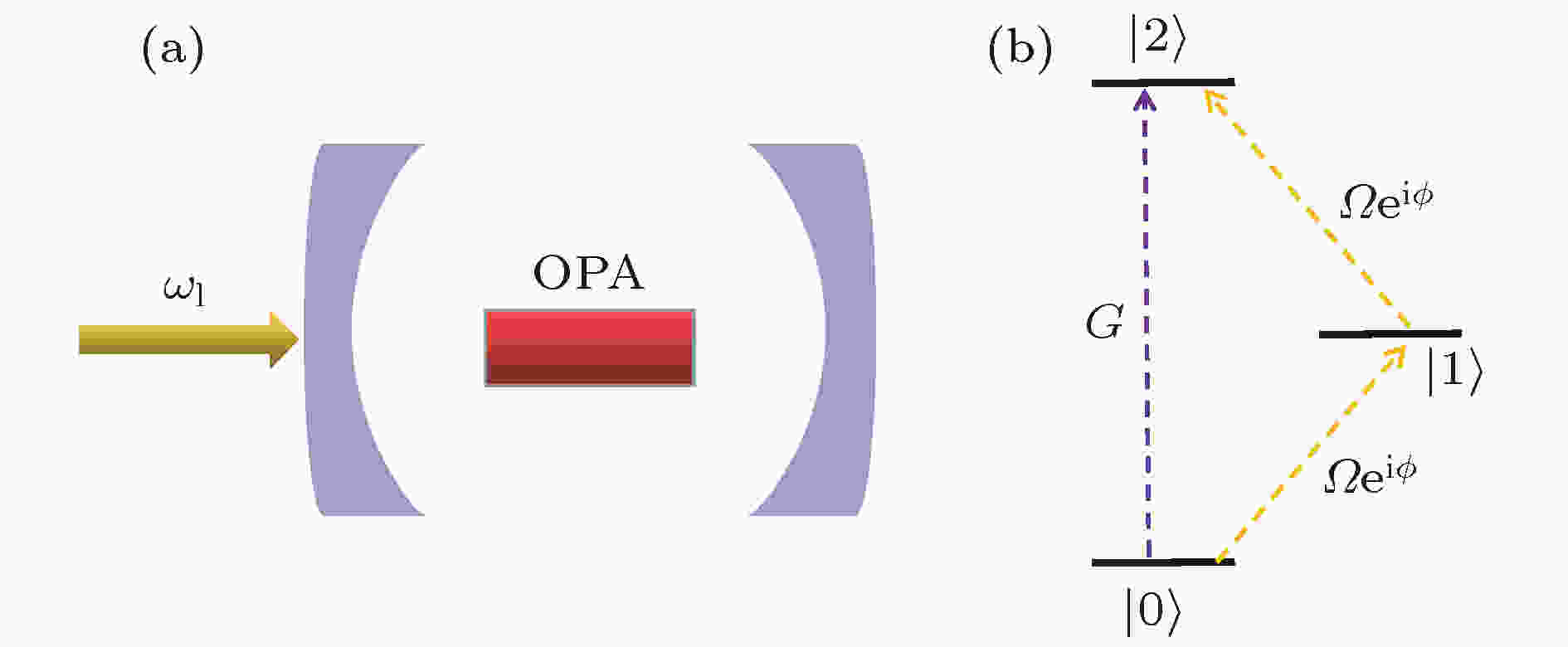
2019, 68 (12): 124203.
doi: 10.7498/aps.68.20190154
Abstract +
In this paper, we present a scheme to realize an unconventional photon blockade effect in a Fabry-Perot cavity and optical parametric amplifier (OPA) composite system. The system includes a tunable phase of complex driving strength, the second-order correlation function is used to describe the photon statistical properties. The numerical simulation of the photon blockade effect is conducted with different parameters. Our calculations show that the unconventional photon blockade effect can be controlled by the tunable phase of complex driving strength. Under the weak driving condition, the exact optimal conditions for strong photon anti-bunching are analytically derived (i.e. the optimal nonlinear gain of optical parametric amplifier and the phase of the field driving for the strong photon anti-bunching are obtained), and obtain the analytic calculations of the second-order correlation function. Under the optimal conditions, we perform a numerical simulation with different parameters. The optimal conditions for strong photon anti-bunching are found by analytic calculations, which are in good agreement with the numerical results. The results provide a platform for coherently operating the photon blockade and have potential applications in quantum information processing and quantum optical devices.

2019, 68 (12): 124204.
doi: 10.7498/aps.68.20190300
Abstract +
In the past years, light-emitting devices (LEDs) based on erbium (Er)-doped insulators or wide-bandgap semiconductors have received intensive attention because the intra-4f transition (4I13/2→4I15/2) of Er3+ ions at ~ 1540 nm has potential applications in the optical interconnection for silicon-based circuits. The LEDs with rare-earth (RE)-doped SiOx (x ≤ 2) or SiNx (x ≤ 4/3) films have been well investigated as the silicon-compatible emitters. However, they suffer difficulty in injecting current and easing fatigue. In this context, the LEDs with RE-doped oxide semiconductors have been extensively investigated out of research interest in recent years. Among the oxide semiconductors, TiO2 is a desirable host for RE-doping because it is transparent for visible and infrared light, and cost-effective, and has considerably high RE solubility. In our previous work (Zhu C, Lü C Y, Gao Z F, Wang C X, Li D S, Ma X Y, Yang D R 2015 Appl. Phys. Lett. 107 131103), we have realized erbium (Er)-related visible and near-infrared (~ 1540 nm) electroluminescence (EL) from the LED with a structure of ITO/TiO2:Er/SiO2/n+-Si, in which TiO2:Er refers to the Er-doped TiO2 film as the light-emitting layer. In this work, we co-dope ytterbium (Yb) into the TiO2:Er film in the aforementioned LED to significantly enhance the Er-related visible and near-infrared EL. It is revealed that a certain amount of Yb co-doping enables the TiO2:Er film to transform its crystal phase from anatase to rutile. Such a phase transformation reduces the symmetry of crystal field surrounding the Er3+ ions incorporated into the TiO2 host. Moreover, the substitution of over-sized Yb3+ ions for Ti4+ ions in the TiO2 host leads to the distortion of the crystal field around the Er3+ ions. The aforementioned symmetry-reduction and distortion of the crystal field increase the probabilities of the intra-4f transitions of Er3+ ions. Due to the aforementioned reason, the Yb co-doping into the TiO2:Er film remarkably enhances the EL from the corresponding LED. It is believed that the strategy of Yb-codoping can be adopted to enhance the EL from the LEDs with other RE-doped TiO2 films.
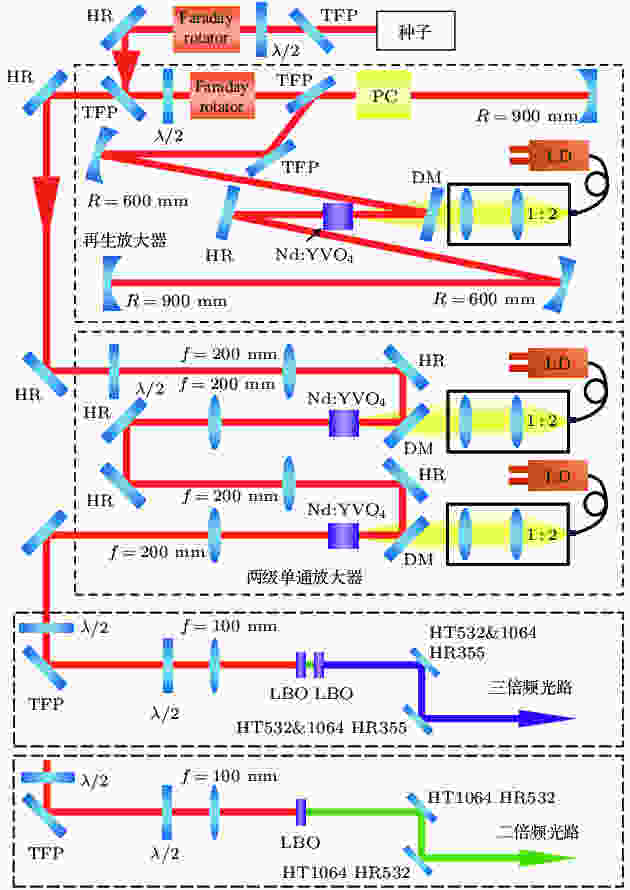
2019, 68 (12): 124205.
doi: 10.7498/aps.68.20190513
Abstract +
Picosecond laser with high-repetition-rate and high pulse energy is widely favorite in many scientific and industrial applications. Some nonlinear crystals can be used to efficiently convert a near-infrared laser into a green laser or an ultraviolet laser which has a higher photon energy and a smaller focal area. Especially for high-quality and high-speed transparent hard material fabrication, green or ultraviolet picosecond laser has been found to possess unique advantages. In this paper, the experiments on high-efficiency second-harmonic-generation (SHG) and third-harmonic-generation (THG) by using a home-made all-solid-state picosecond laser amplifier and an LBO crystal are reported. The picosecond laser amplifier consists of a seed source, a regenerative amplifier and a two-stage single-pass amplifier. The seed source is a commercial all-solid-state picosecond oscillator with a pulse duration of 8.3 ps and a repetition rate of 68 MHz. The repetition rate is reduced from 68 MHz to 500 kHz by an electro-optic Pockels cell (PC), and the period doubling bifurcation is minimized by reducing the duration of high voltage in PC. Both the regenerative amplifier and the two-stage single-pass amplifier are pumped by three 30-W continuous-wave fiber-coupled laser diodes. After the regenerative amplifier, the seed laser is amplified to 4.86 W with a repetition rate of 500 kHz at 1064 nm. Then the laser power is increased to 23.2 W by a two-stage single-pass amplifier, and the M2 value of the amplified laser in the X direction and in the Y direction are 1.330 and 1.235, respectively. The final pulse duration is 13.4 ps, which is slightly stretched in the amplification chain compared with the seed pulse duration (8.3 ps). For high-efficiency SHG and THG from near-infrared to green and ultraviolet, we carefully study the optical characteristics of some nonlinear crystals, such as LBO, BBO, BIBO, CLBO, etc., and we find that the LBO crystal, which has a high damage threshold, small walk-off and high nonlinear coefficient, is the best choice for both SHG and THG. Then the parameters of the two crystals for SHG and THG are specially designed according to the phase matching condition, the walk-off and the laser parameter. As a result, a 4-mm-long type-I phase matching LBO with cutting angle of θ = 90° and φ = 11.6° is used for SHG, and a 3-mm-long type-II phase matching LBO with cutting angle of θ = 42.2° and φ = 90° is used for THG. Finally, we realize high-efficiency frequency conversion with SHG power of 12.7 W at 532 nm and THG power of 9.25 W at 355 nm. The corresponding optical-optical conversion efficiencies reach 54.7% and 39.6%, respectively.

2019, 68 (12): 124301.
doi: 10.7498/aps.68.20190101
Abstract +
The traditional Lamb wave structure health monitoring imaging method based on reference signal is affected by environmental factors such as temperature change. To solve this problem, considering the difference in the scattered fields generated by the interaction between ultrasonic waves and defects in the reverse path, a Lamb wave imaging method is proposed in this paper based on the difference signal of sparse array in inverse path. Numerical simulations are carried out to determine the generation conditions of difference signal in inversion path, and the influences of the angles and distances between the defect and the two sensors on the amplitude of difference signal in inversion path. It is found that the difference signal in reverse path is much more obvious when the defect appears as asymmetric distribution towards the excitation sensor and receiving sensors; the amplitude of difference signal in inverse path is affected by distance difference of the Lamb wave propagating in reverse path and the scattering coefficient of the defect. On this basis, the effectiveness of the Lamb wave imaging method based on the difference signal in inverse path is studied numerically and experimentally. The results show that the Lamb wave imaging method based on the difference signal in inversion path can perfectly eliminate the interference between direct wave and the boundary reflection wave, and the imaging method can detect the defect at different positions in the plate. Moreover, the imaging resolution is higher and the defect location is accurate. The research work provides a new feasible scheme for the extensive health monitoring of plate structure.
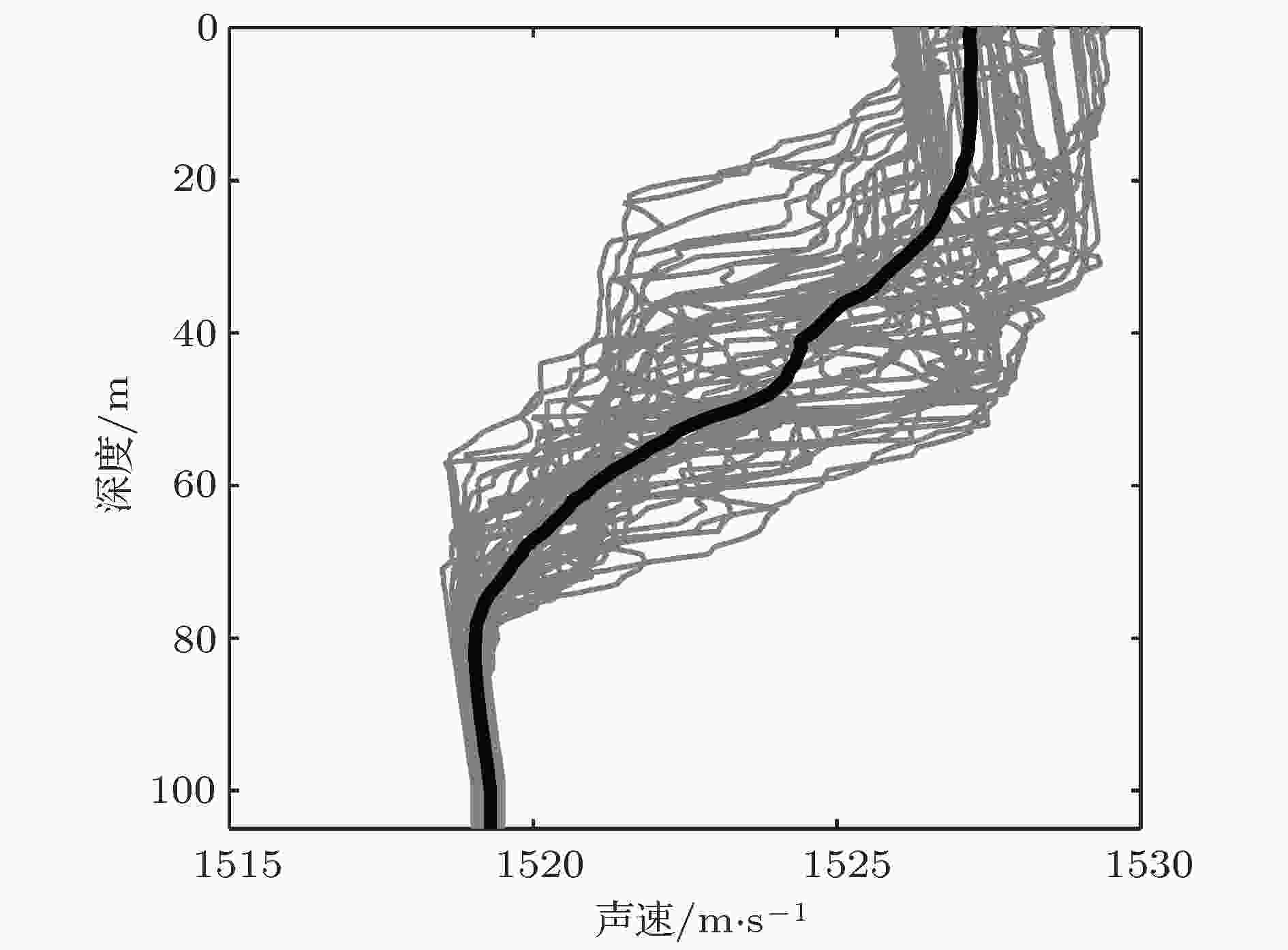
2019, 68 (12): 124302.
doi: 10.7498/aps.68.20181867
Abstract +
In order to provide constraint to the number of inversion parameters, sound speed profile is often modeled by empirical orthogonal functions (EOFs). However, the EOF method, which is dependent on the sample data, is often difficult to apply due to insufficient real-time in-situ measurements. In this paper, we present a novel basis for reconstructing the sound speed profile, which can be obtained by using historical data without real-time sample. By deducing the dynamic equations and the state function of water particle, the hydrodynamic mode bases (HMBs) can be calculated from historical data without real-time in-situ measurement, and a method of constructing the sound speed profile is established by using the dynamic characteristics of seawater. The use of the World Ocean Atlas 2013 (WOA13) can obtain the seasonal profiles of temperature and salinity, and then the HMB which represents the dynamic characteristic of internal tides is obtained and analyzed. Unlike EOF, the HMB and its projection coefficients are directly related to the sea dynamic features and have a more explicit physical meaning. According to the orthogonality analysis of hydrodynamic mode, the first-order coefficient can be used to describe the depth change of sound speed iso-lines and the second-order coefficient can be used to describe the change of sound speed gradient. Based on the conductance-temperature-depth profiles and broadband data from underwater explosion collected in the East China Sea experiment of the Asian Seas International Acoustic Experiment, the HMB is tested and compared with the EOF in the sound speed profile reconstruction and matched field tomography. The results show that the sound speed profile in shallow water area can be expressed by the HMB with proper precision. By means of the conventional matched field tomography, the valid sound speed profile can also be obtained in the form of HMB coefficients. The result of transmission loss prediction and tomography from HMB are as good as those from EOF, while the HMB has less dependent on real-time in-situ measurement. The HMB is easy to obtain and closely related to the physical characteristics of seawater, it can be used as an efficient alternative to EOF for monitoring the marine dynamic phenomena in sea areas with insufficient real-time in-situ measurement.

2019, 68 (12): 124701.
doi: 10.7498/aps.68.20190126
Abstract +
The harmonic balance method (HBM) is an efficient frequency-domain approach to computing periodically unsteady flows. The basic principle of this method is to decompose the flow variables into a Fourier series, and transform the unsteady flow into several steady problems coupled by a spectral time-derivative operator, from which the whole time history of a complete unsteady periodic flow can be reconstructed. In the present work, we investigate the ability of the HBM to be used for modeling the periodic unsteady vortex shedding behind a bluff body at low Reynolds numbers via solving the unsteady incompressible Navier-Stokes equations. For the periodic problem where the time period T of the unsteadiness is unknown, a variable-time-period method based on residual gradients is used to compute the exact time period iteratively starting from an initial guess T0. By simulating the two-dimensional laminar flows over a circular cylinder and a square cylinder, the accuracy and efficiency of the HBM are investigated and the effects of different parameters on the final results are analyzed. Comparisons with the results of fixed-time-period HBM using a constant time period are also implemented. Three practical methods of optimization are used to iterate the time period, and the values of accuracy and efficiency of different methods are compared with each other. The results show that the HBM can accurately capture the complex nonlinear flow field physics with only three harmonics. The Strouhal frequency and mean drag coefficient each as a function of the Reynolds number agree well with existing experimental and computational data. For both test cases, the computational efficiency of HBM is higher than that from the traditional time-domain method. For the square cylinder test case, the HBM offers speedup rate up to nearly 18 times. The real time period of vortex shedding can be predicted by the gradient based variable-time-period method, and the final result is insensitive to search step λ. The calculation result is sensitive to the initial T0, and when such a variable is greater than a certain value, the result will converge to an approximate integer multiple of the real one. Therefore, it deserves further exploration on how to specify this initial condition. The shedding time periods computed by different optimization methods are converged to the same value. The computational efficiency from the FR conjugate gradient method and that from Newton method are both equivalent to that from the steepest descent method with the maximum search step λ = 100. Avoiding prescribing parameters such as the search step λ, the Newton method possesses higher application value in engineering calculation than the other two schemes.
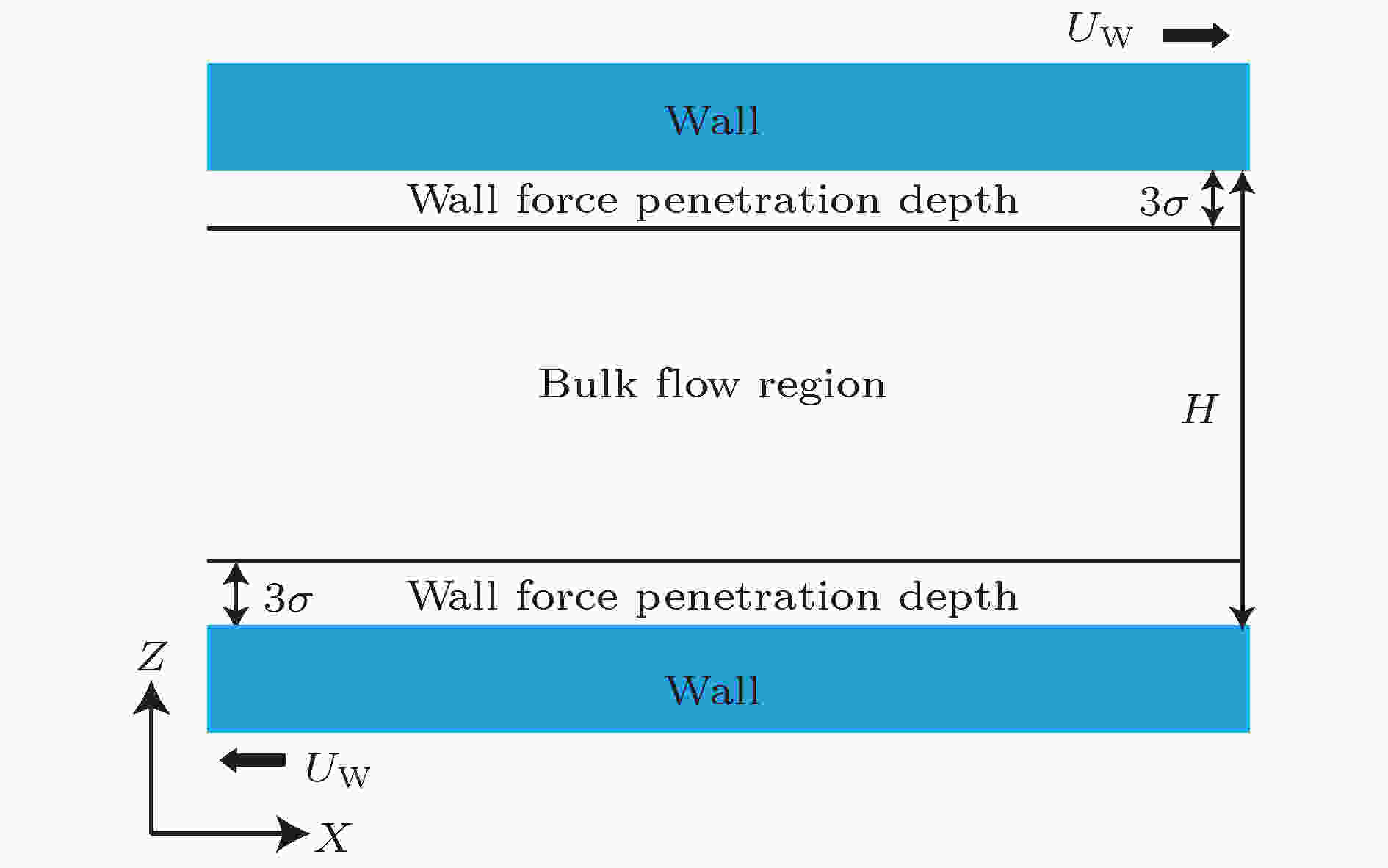
2019, 68 (12): 124702.
doi: 10.7498/aps.68.20190248
Abstract +
A three-dimensional non-equilibrium molecular dynamics method is adopted to investigate the influence of wall force field on the nanoscale gas flow in the transition regime. For the gas flow under nanoscale condition, the dominant effect of the wall force field on the flow field is more obvious, and the flow physical quantity is more sensitive to the change of the wall condition and system temperature. The motion of the wall atoms is governed by the Einstein theory, with using an elastic coefficient k to model the surface stiffness. The results indicate that the surface stiffness has little effect on the physical quantity distribution of the bulk flow region, but a certain influence on that of the near wall region. Increasing the value of the stiffness changes the velocity peak of the gas in the near-wall region and the tangential momentum adaptation coefficient (TMAC) towards lower values, thus demoting the momentum adaptability of the gas molecules to the surface. The wall roughness is simulated by a typical pyramidal model. It is found that the influence of wall roughness on the flow is very obvious, whether it is in the bulk flow region or in the near wall region. For the former case, the increase of roughness leads gas velocity and shear stress to increase, with density and normal stress remaining constant. The linear distribution of physical quantities is also affected to some extent. While for the latter case, as the roughness increases, the velocity of the fluid increases rapidly and approaches to the wall velocity. The peak of density increases, and the adsorption of gas molecules at the surface is obvious. The TMAC approaches to 1, suggesting that the gas and the surface achieve a complete momentum adaptation. Besides, the influence of system temperature on the gas flow in the nanochannel is also studied. The system temperature is controlled by the Nose-Hoover thermostat, making the flow field maintained at the target temperature through the damping coefficient. The results show that the effect of temperature is global in the whole flow region. The increase of temperature causes the flow velocity of the whole flow field to decrease, while the normal stress and shear stress to increase. A higher temperature leads to more frequent collisions between gas molecules, thus increasing the effective viscosity of the gas. At the same time, the degree of gas molecule adsorption in the near-wall region is reduced, contributing to a smaller TMAC value, and consequently a weaker gas-surface interaction.
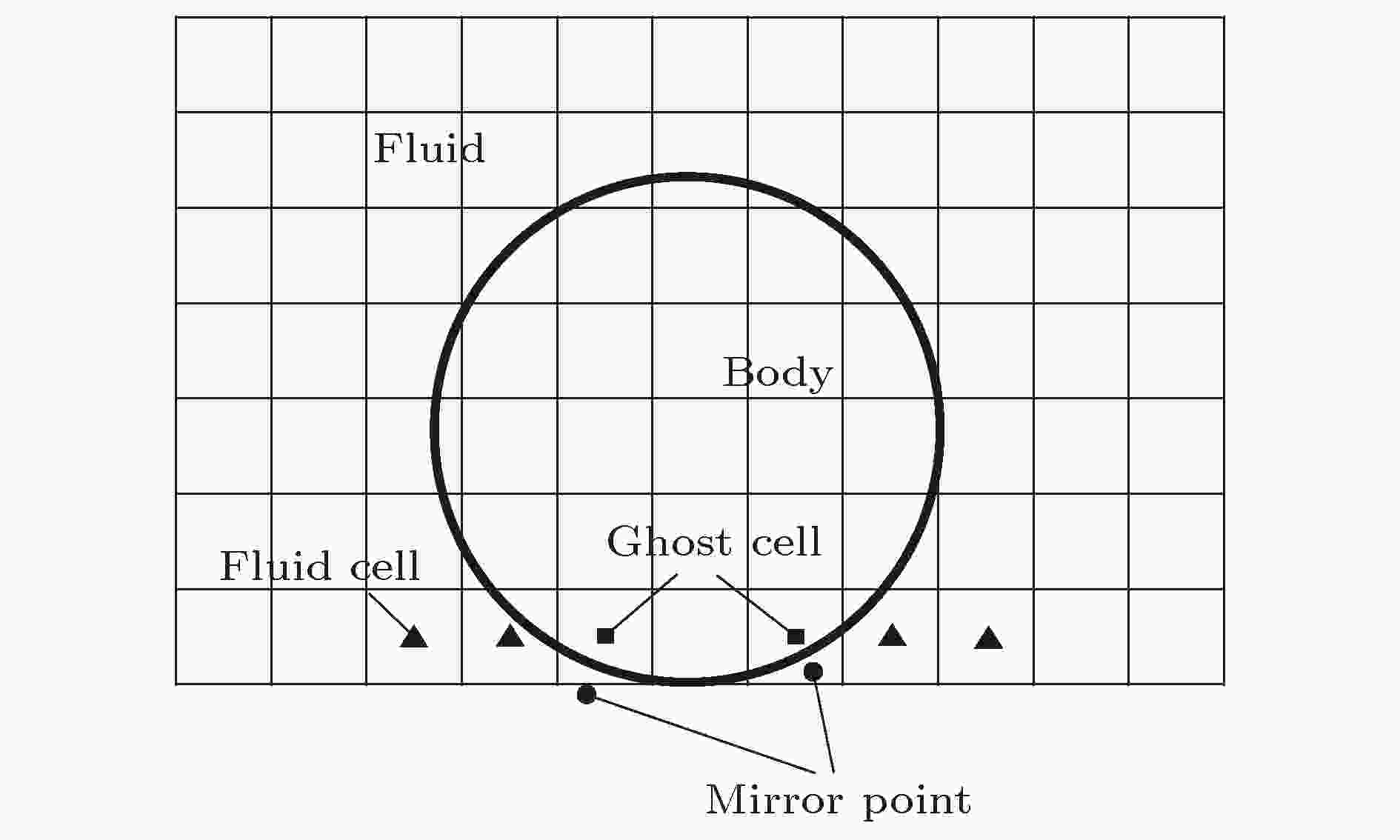
2019, 68 (12): 124703.
doi: 10.7498/aps.68.20190013
Abstract +
In this paper, an improved ghost cell method is implemented to solve flow problems with static and moving boundary. The two-dimensional unsteady compressible Euler equations are discretized on a fixed Cartesian grid by the finite volume method, and the monotonic upstream-centered scheme for conservation law scheme is adopted to obtain the second-order precision by reconstructing the numerical fluxes computed by the AUSM + (advection upstream splitting method +) scheme. In time discretization, the explicit third-order total-variation-diminishing Runge-Kutta method is considered. To simplify the assignment method for the ghost cells and deal with the slit problem, the cells in the flow field are selected as the mirror points, which avoids complex interpolations. For preventing non-physical solutions when the mirror point is very close to the boundary, the current mirror point will be replaced by another one, which is regarded as the second flow field cell located in the direction away from the boundary. Moreover, properties of a ghost cell along the X and Y direction are computed respectively, and then the final property is obtained by using a weighted average method, where the weight is determined by the distance between the ghost cell and corresponding boundary point. In this method, the selection of mirror points does not change abruptly for adjacent ghost cells, and therefore, no kink occurs. Furthermore, considering the gradient of the variable near the boundary, an extended scheme of the improved ghost cell method is achieved, which can deal with the flow problems with moving boundaries. When computing the property of a ghost cell by using the extended scheme, the result may be wrong if the location of a shock is just between two mirror points. In view of the problem above, a shock monitor is implemented to switch to the appropriate approach, that is, when the monitor detects a shock between mirror points, the extended scheme will be replaced by the original ghost cell method. Two typical test cases are investigated to validate the accuracy of the proposed method. The first test case is the Schardin’s problem, in which a shock impinges on a finite wedge and is reflected and diffracted. The results at different grid sizes are obtained, and good agreement with experiment results as well as the previous numerical results is achieved, which shows that the improved ghost cell method can offer the same precision as the body-fitted grid method. The second test case is the cylinder lift-off problem involving moving boundaries and the slit problem. Good agreement with the previous results of a high-order complex ghost cell method shows that the improved simple ghost cell method can meet the requirement for dealing with flow problems with moving boundaries.
PHYSICS OF GASES, PLASMAS, AND ELECTRIC DISCHARGES
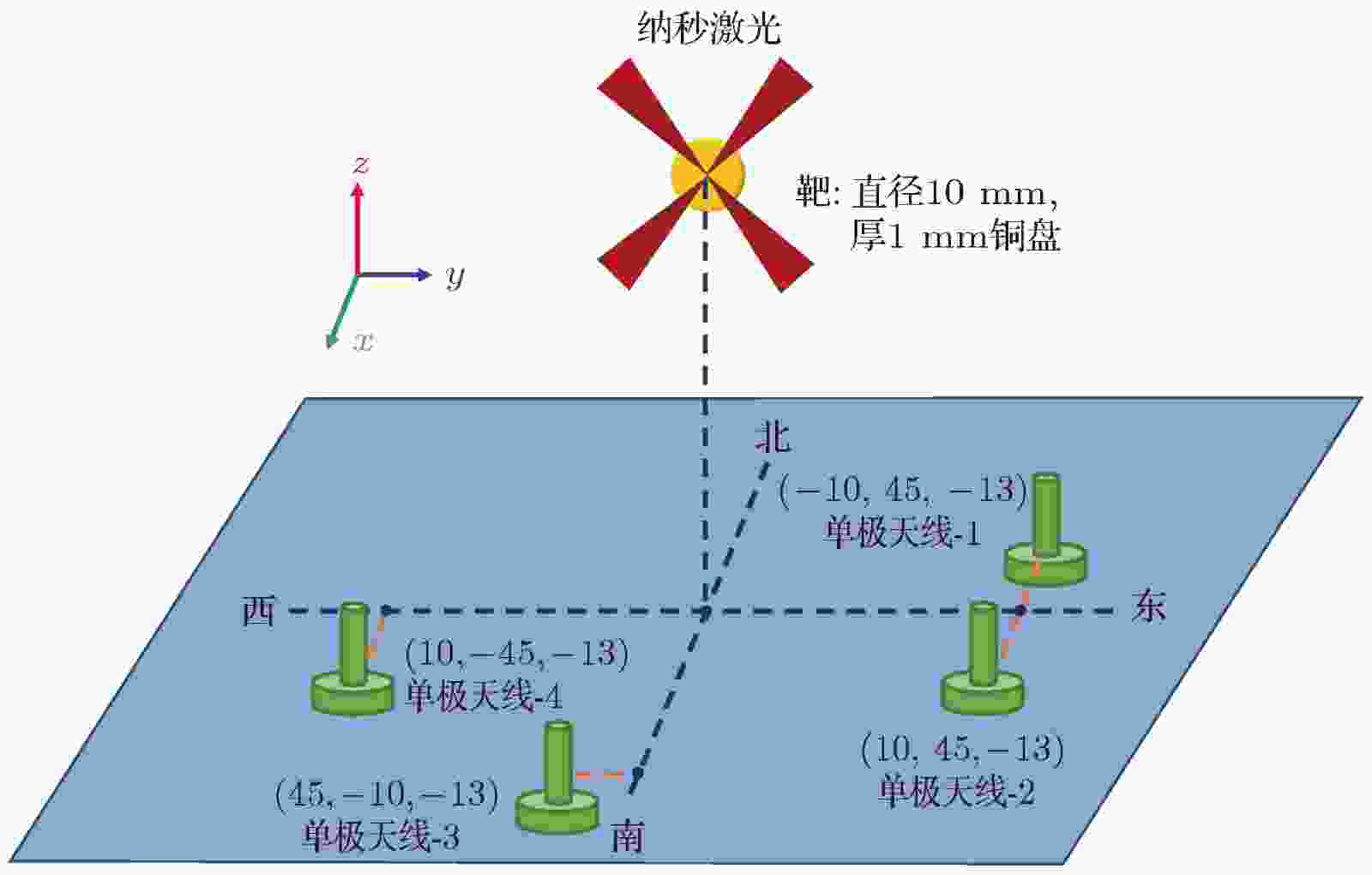
2019, 68 (12): 125201.
doi: 10.7498/aps.68.20190501
Abstract +
Microwave radiation in several gigahertz frequency band is a common phenomenon in laser-plasma interactions. It can last hundreds of nanoseconds and cause huge electromagnetic pulse disturbances to electrical devices in experiments. It has been found that the microwave radiation might originate from the oscillation of charged chambers, the return current on target holders, the dipole radiation, the quadrupole radiation, and the electron bunch emitted from the plasma to the vacuum. The microwave radiation waveform, frequency spectrum, and intensity depend on many factors such as laser pulse, target, and chamber parameter. To distinguish the microwave radiation mechanisms, the influence of the experimental parameters on the radiation characteristics should be investigated systematically. In this paper we investigate the microwave radiation influenced by the laser intensity in nanosecond laser-plasma interactions. It is found that the microwave radiation intensity varies nonmonotonically with the laser intensity. For the lower laser intensity, the radiation intensity first increases and then decreases with laser intensity increasing, the radiation field continuously oscillates in tens of nanoseconds, and the radiation spectrum contains two components below and above 0.3 GHz, respectively. For the higher laser intensity, the radiation intensity increases with the laser intensity increasing, the radiation field has a unipolar radiation lasting tens of nanoseconds, and the radiation spectrum mainly includes the component below 0.3 GHz. The waveform and spectrum analysis show that these phenomena are due to the difference of the radiation mechanisms at different laser intensities. The frequency component below and above 0.3 GHz are induced by the electron bunch emitted from the plasma to the vacuum and the dipole radiation respectively. At low laser intensity, both the dipole radiation and the electron bunch emitted from the plasma contribute to the microwave radiation. At high laser intensity, the microwave radiation is mainly produced by the electron beam emitted from the plasma to the vacuum. This work is significant for understanding the microwave radiation mechanisms in nanosecond laser-plasma interactions, and implies the potential to provide a reference to the diagnosing of the escape electrons and the sheath field on the target surface by the microwave radiation in laser-plasma interaction.
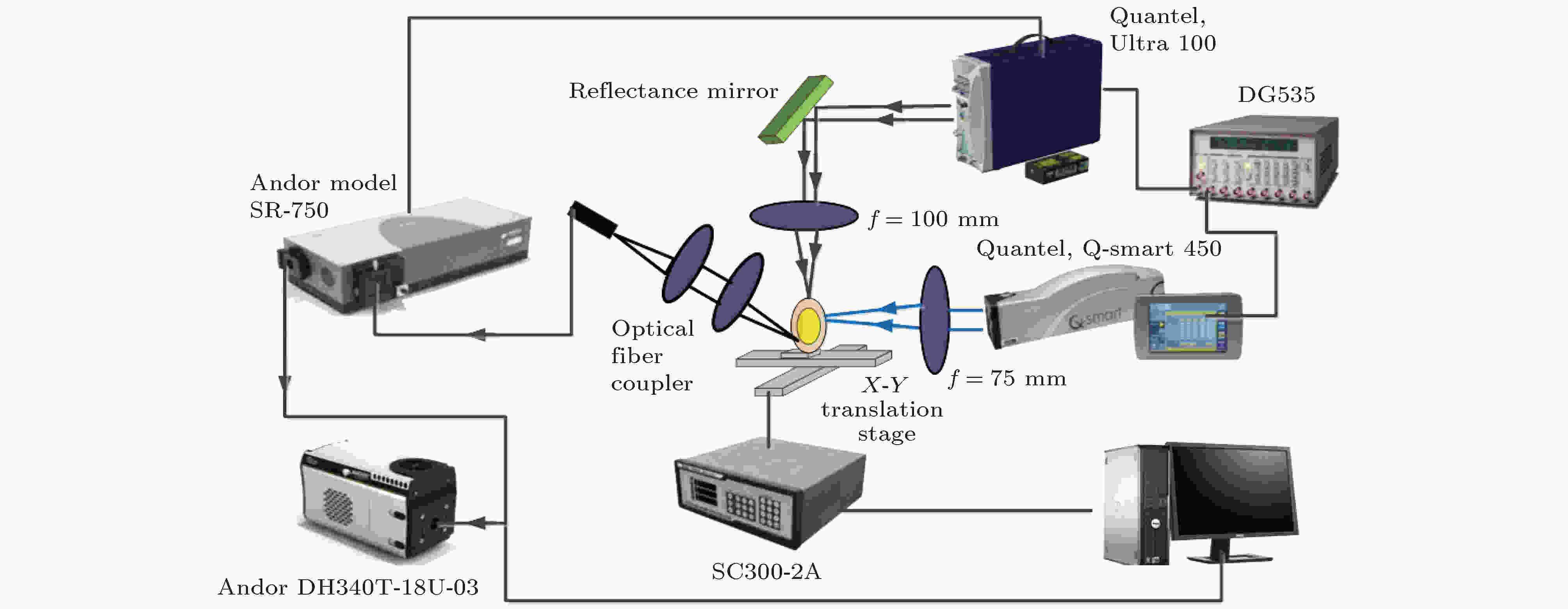
2019, 68 (12): 125202.
doi: 10.7498/aps.68.20190148
Abstract +
Coptidis plays an important role in the field of traditional Chinese medicine. However, it is easily polluted by heavy metals in environment (water and soil), and thus can affect human health. In order to detect the heavy metal elements Cu and Pb in Coptidis, which was purchased from the Chinese herbal medicine market in Chongqing, the reheated double-pulse laser-induced breakdown spectroscopy (RDP-LIBS) is investigated. In order to reduce the experimental error caused by the irregular shape, it is necessary to pretreat the Coptidis samples prior to the determination step. The Coptidis samples are dried, milled, and sieved to form thin cylindrical tablets each with a diameter of 13 mm and thickness of 2 mm, which are formed under a mechanical press of 10 MPa for 2 min. The influences of the main experimental parameters, such as double-pulse LIBS detection delay, double-pulse LIBS laser energy, and double-pulse LIBS pulse interval are optimized. According to the LIBS signal intensity and signal-to-background ratio, the optimal laser energy set of the characteristic line Cu I (324.46 nm) covers E1 = 15 mJ and E2 = 35 mJ, and the pulse interval and detection delay time are 1.4 μs and 1.5 μs respectively; the laser energy set of Pb I (405.78 nm) also covers E1 = 15 mJ and E2 = 35 mJ, and the pulse interval and detection delay time are 1.6 μs and 1.7 μs, respectively. Comparing with the scenarios of single-pulse laser-induced breakdown spectroscopy, it can be seen that the spectral intensity of Cu I (324.46 nm) increases from 5779 counts to 12749 counts, i.e. it increases about 2.2 times; the spectral intensity of Pb I (405.78 nm) characteristic line increases from 4703 counts to 15838 counts, i.e. it increases about 3.3 times. It is shown that the second laser pulse re-excites the plasma which is generated by the first laser pulse, thus making the plasma emission spectrum stronger. The detection performances of heavy metal elements in Chinese medicinal materials are evaluated by RDP-LIBS and SP-LIBS. The results show that the detection limit of Cu decreases from 5.13 mg/kg to 1.91 mg/kg, and the detection limit of Pb decreases from 10.87 mg/kg to 3.03 mg/kg. There was observed a noticeable difference in the limit of detection between Cu and Pb, which meets the requirements of the Green Industry Standard for Import and Export of Medicinal Plants. Moreover, the linear curve fitting degree of RDP-LIBS is higher than that of SP-LIBS, which indicates that the RDP-LIBS technology has better detection performance in Chinese herbal medicine.
CONDENSED MATTER: STRUCTURAL, MECHANICAL, AND THERMAL PROPERTIES
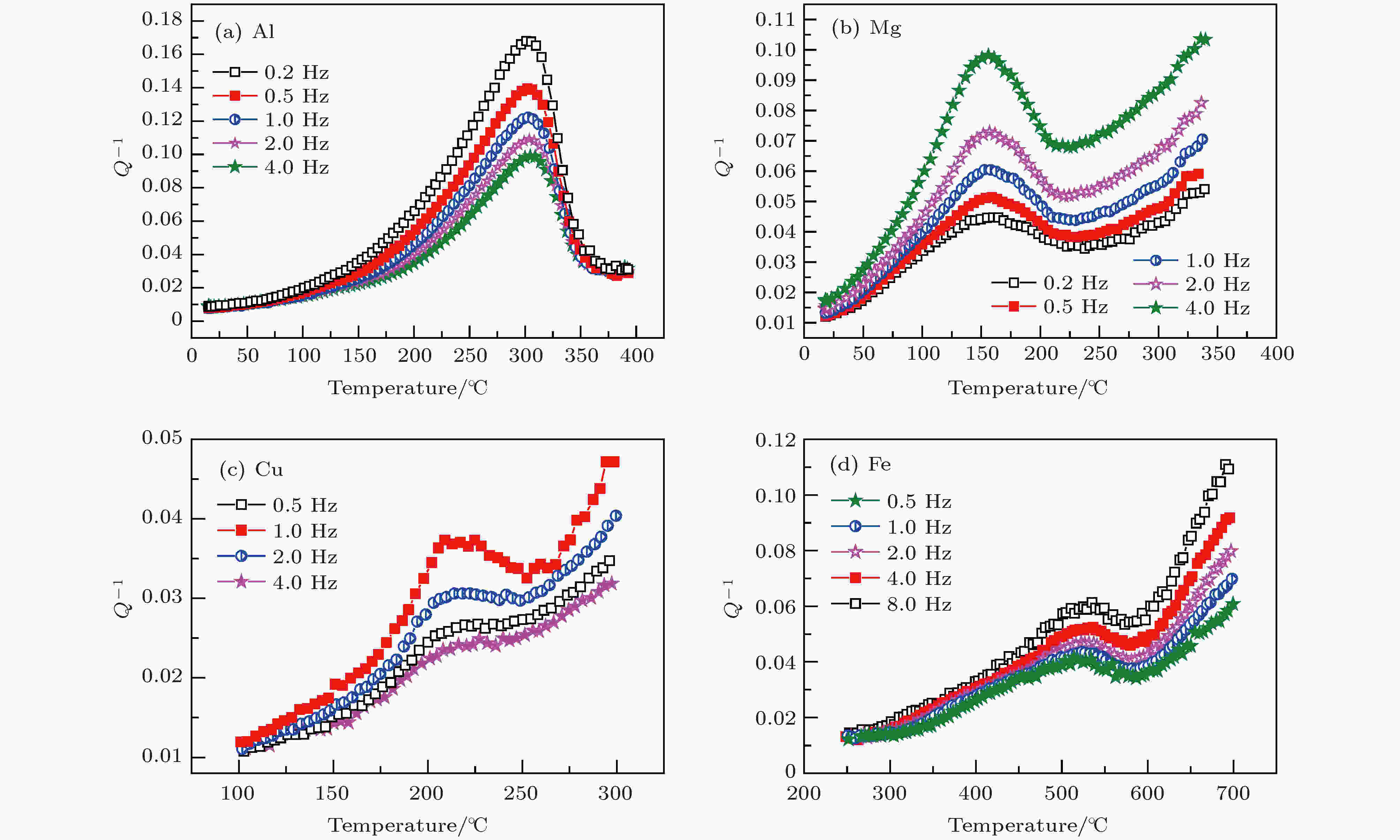
2019, 68 (12): 126101.
doi: 10.7498/aps.68.20190031
Abstract +
Sintering plays a decisive role to determine final product quality in the powder metallurgy process. Understanding the law of structure and defects as well as determining the initial sintering temperature and crystallization temperature will prove clear information to determine favorable sintering technology for the powder compacted billet. In this paper, the internal friction characteristics in the sintering process for powder compact billet, pure Al, Mg, Cu, Fe are systematically studied in terms of internal friction technology. Two internal friction peaks, named heating peak and cooling peak are respectively found in the first run. The cooling peak is a stable relaxational internal friction peak. It is concluded that the peak is associated with the viscous sliding of grain boundary based on the activation energy and peak temperature location. The heating peak is an unstable internal friction peak corresponding to the decline of resistance and relative dynamic modulus, the peak temperature being considered as an initial sintering temperature due to the great change of material performance. Furthermore, the heating peak is dependent on powder particle size and compressing pressure, which increases with the decrease of particle size or compressing pressure. The dependence can be understood according to the increase of weak bonding interface and activated slipping distance between powder particles. The internal friction of the powder compacted billet in the heating process gradually increases with the temperature increasing, which is mainly due to the micro sliding of the weak bonding interface, but the enhancing trend stops and internal friction rapidly declines when the temperature approaches to the peak location due to the transition of weak bonding interface to grain boundary, as a result, leading to the formation of the heating peak. The occurrence of therising temperature peak indicates the formation of grain boundary between powder particles in the sintering process of powder compacted billet. Correspondingly, the peak temperature can be used as a crystallization temperature.
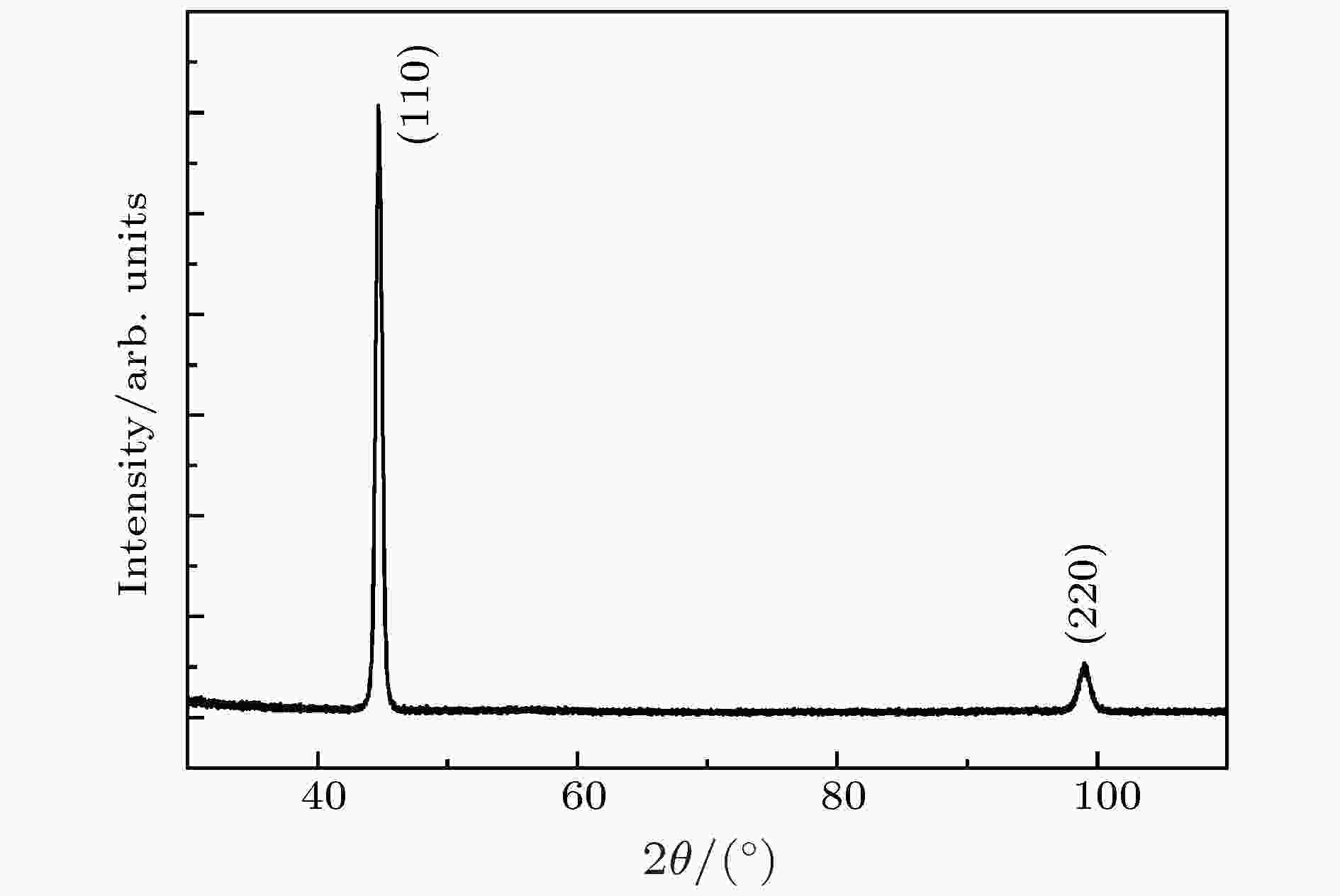
2019, 68 (12): 126102.
doi: 10.7498/aps.68.20190131
Abstract +
In order to study the effect of ion implantation on the in-plane magnetic anisotropy of epitaxial magnetic films, a 3-nm Al buffer layer is epitaxially grown on an Si (111) substrate with a miscut angle, and then 25-nm Fe is grown on the buffer layer. High-resolution X-ray diffraction reveals that the epitaxial Fe film has a (111)-oriented bcc structure. The epitaxial Fe films are implanted by 10 keV N+ ions with dose up to 5 × 1016 ions/cm2. The change and mechanism of the in-plane magnetic anisotropy of the epitaxial Fe film are studied systematically. It is found that the in-plane magnetic anisotropy of the epitaxial Fe film is gradually changed from two-fold to six-fold symmetry with the increase of N+ implantation dose. It is confirmed by transmission electron microscopy and etching experiments that ion implantation changes the surface and interface state of Fe film. This result is consistent with the result from the SRIM software simulation. The in-plane magnetic uniaxial anisotropy of epitaxial Fe film comes from atomic steps at the surface and the interface of the Fe film. These steps result from Si (111) substrate with a miscut angle. Ion implantation has effects on sputtering and atomic diffusion. The sputtering effect causes the step at the surface of the Fe film to be erased, and the diffusion of the atom leads the step at the interface of the Fe film to disappear. The in-plane uniaxial anisotropy induced by the atomic step is weakened, and the magnetocrystalline anisotropy induced by the Fe (111) plane is dominant. Therefore, the epitaxial Fe film exhibits Fe (111) plane induced six-fold magnetic symmetry after high-dose N+ implantation. This work indicates that the in-plane magnetic anisotropy of Fe films epitaxially grown on Si (111) substrate with miscut angle can be modified and precisely controlled by ion implantation. This work may be of practical significance for improving the density of in-plane magnetic recording material.
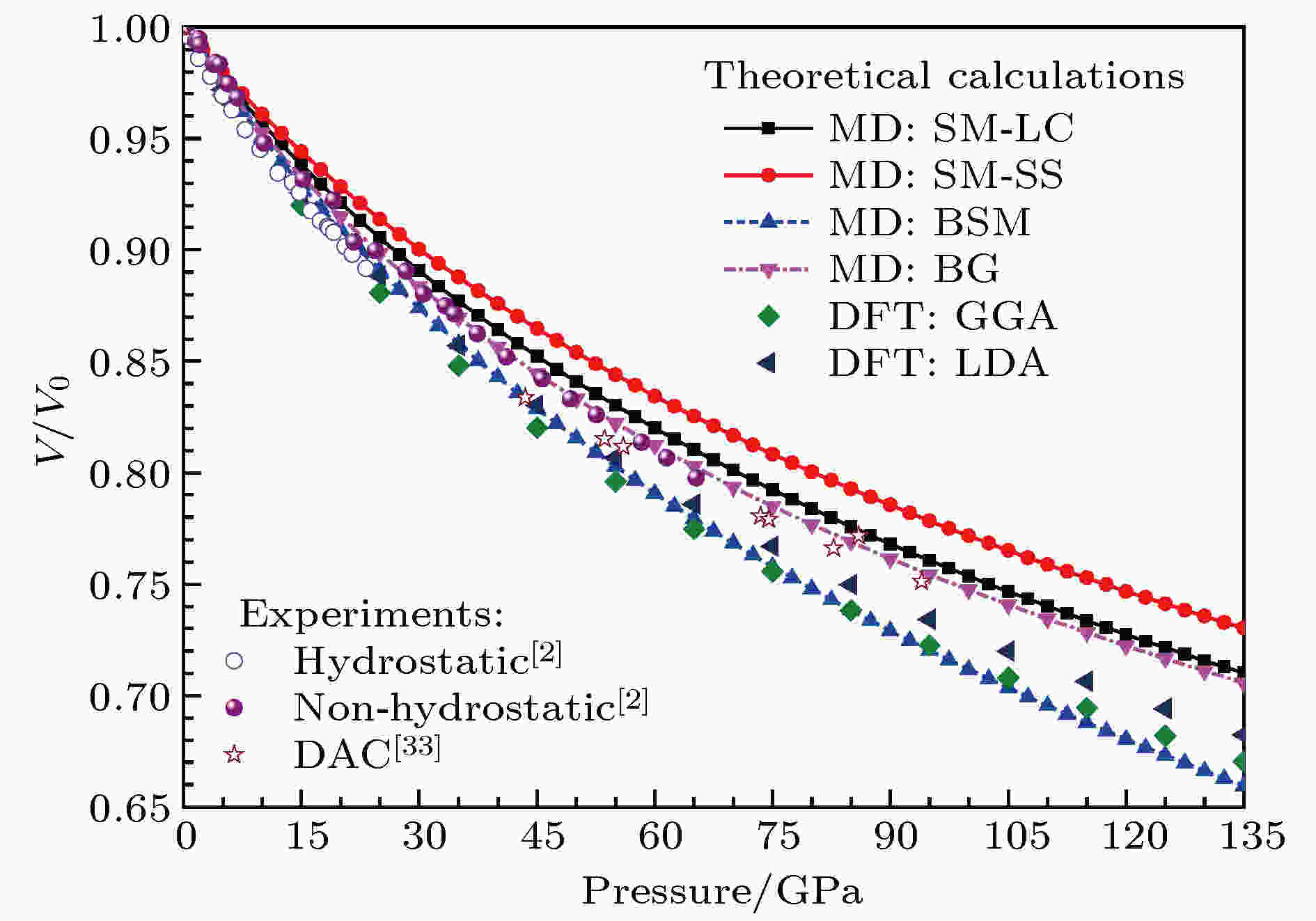
2019, 68 (12): 126201.
doi: 10.7498/aps.68.20190204
Abstract +
Periclase is the terminal component of the ferropericlase, and its chemical composition is MgO. It is well known that there exists a huge difference between the melting curves of MgO determined experimentally and theoretically. A feasible way to clarify the nature of the melting temperature is to investigate the possible new phase of MgO. Meanwhile, it is very important to study the new phase and the influence of temperature on structural stability of MgO in high-pressure condensed matter physics and geophysics. In the present work, we study in detail the phase stability and the possible existing structures of MgO, which include the structure predicted by particle swarm optimization algorithm through using the first-principles pseudopotential density functional method. We find that MgO crystallizes into a rocksalt structure in a pressure range from 0 to 580 GPa and that the CsCl-type structure is of a high-pressure phase at up to 800 GPa. Although an NiAs-type hexagonal phase perhaps explains the volume discontinuity at (170 ± 10) GPa along the MgO Hugoniot in a shock-compression experiment (Zhang L, Fei Y W 2008 Geophys. Res. Lett. 35 L13302) and a wurtzite phase perhaps explains the huge difference between the melting curves of MgO determined experimentally and theoretically (Aguado A, Madden P A 2005 Phys. Rev. Lett. 94 068501), neither of them is existent in the entire range of pressures studied, according to the thermodynamic stability calculations. The calculations of phonon spectra indicate that the B3, B4, B81, B82, and P3m1 phases of MgO are dynamically stable at zero pressure. That is to say, all of the predicted structures are the metastable structures of MgO. In addition, the high-temperature structural stability of MgO is investigated by using very similar Lewis-Catlow and Stoneham-Sangster shell model potential based on the classical molecular dynamics (MD) simulations. In order to take into account the non-central force in crystal, the breathing shell model is also introduced in simulation. The thermodynamic melting curves are estimated on the basis of the thermal instability MD simulations and compared with the available experimental data and other theoretical results in the pressure range of 0-150 GPa.
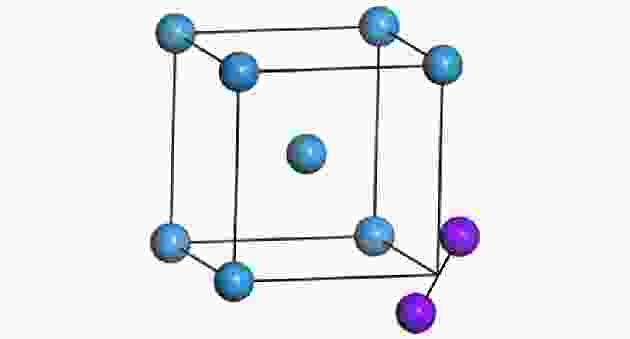
2019, 68 (12): 126701.
doi: 10.7498/aps.68.20190310
Abstract +
Tungsten, due to its desirable properties (high melting point, low sputtering coefficient, good irradiation resistance etc.), is considered as a promising candidate for the plasma facing materials in future nuclear fusion reactors. Therefore, it will work in extremely harsh environments because it is subjected to the bombadement of high-flux plasma particles and the irradiation of high energy neutrons, resulting in vacancies and interstitials. The migration behavior of self-interstitial atoms is one of the most important factors determining the microstructure evolution in irradiated metals because it will greatly affect the mechanical properties of materials. The study of the diffusion behavior of di-interstitials with different configurations contributes to a better understanding of the self-interstitial atom behavior in tungsten. Despite the inherent difficulty in experimental approaches, atomistic simulation provides an effective means of investigating the defect evolution in materials. In this paper, based on the newly developed interatomic potential for W-W interaction, the diffusion behavior of self-interstitial atoms in tungsten is studied by molecular dynamics simulation. This work focuses on the investigation of the diffusion behavior of di-interstitials with different configurations at different temperatures. The obtained results show that the di-interstitials with the first nearest neighbor configuration presents the one-dimensional migration in the $\left\langle 111 \right\rangle $ direction at temperatures below 1400 K. As the temperature increases, it makes rotations from one $ \left\langle 111 \right\rangle$ - to other $\left\langle 111 \right\rangle $ -directions. Thus migration of di-interstitial atoms with the first nearest neighbor configuration exhibits a change in mechanism from one-dimensional to three-dimensional migration, keeping the stable $\left\langle 111 \right\rangle $ configuration in the whole investigated temperature range. The migration of di-interstitial atoms with the second nearest neighbor configuration is one-dimensional along the $\left\langle 111 \right\rangle$ direction within a certain temperature range. When the temperature is above 600 K, the di-interstitial atoms will dissociate into two individual self-interstitial atoms and move independently. However, the migration of di-interstitial atoms with the third nearest neighbor configuration dissociates at a temperature just above 300 K. The non-parallel self-interstitial atoms form a sessile configuration within a certain temperature range. Once the sessile cluster is formed it can hardly move. Interestingly, it will transform into mobile defect when the temperature is higher than 1000 K. By comparing the migration energy values of these configurations obtained by nudged elastic band method with those of the Arrhenius fits, we find that the diffusivity for each of single- and di-interstitial atoms in tungsten is a linear function of temperature rather than Arrhenius as usually assumed.
CONDENSED MATTER: ELECTRONIC STRUCTURE, ELECTRICAL, MAGNETIC, AND OPTICAL PROPERTIES
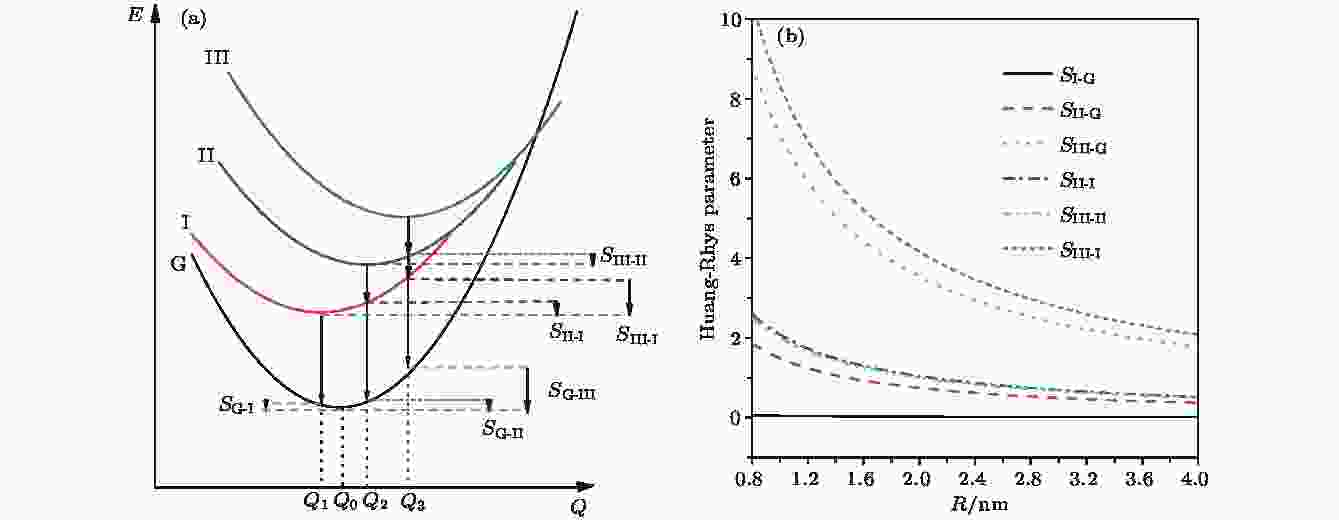
2019, 68 (12): 127301.
doi: 10.7498/aps.68.20190187
Abstract +
Within the frame of lattice relaxation model, several intraband relaxation processes between the three lowest excited states and ground state in a PbSe quantum dot are studied based on the electron-longitudinal optical phonon coupling via Fröhlich mechanism. We find that Huang-Rhys factors decrease with the radius of quantum dot increasing in different relaxation processes. More important is the fact that the obtained values of Huang-Rhys factors satisfy the experimental measurements in the strong coupling limit. These intraband relaxation processes follow the asymmetrical Gaussian distribution with respect to the radius, in which the probabilities with which these intraband relaxation transitions occur are different. Among these relaxation processes, two intraband transitions from the third excited state to ground state and to second excited states dominate the relaxation processes on a several nanometer scale of radius. Moreover, the temperature dependence for each of these relaxation processes can be modulated by the radius of quantum dot. These theoretical results are consistent with the experimental measurements and provide an important insight into the intraband relaxation in quantum dots in experiments.
INTERDISCIPLINARY PHYSICS AND RELATED AREAS OF SCIENCE AND TECHNOLOGY
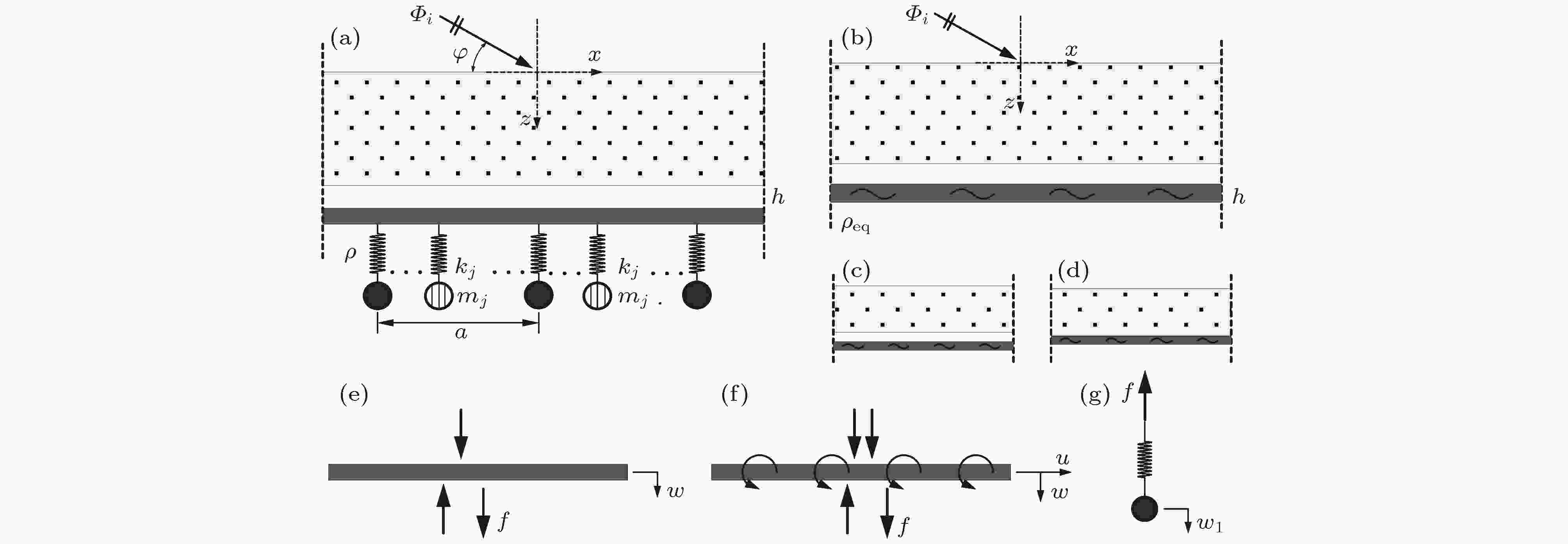
2019, 68 (12): 128101.
doi: 10.7498/aps.68.20190164
Abstract +
To obtain excellent sound reduction performance, in this paper we introduce a novel periodic poroelastic composite structure, which combines poroelastic material and periodic structure and aims at using the remarkable acoustic performance of these two. This periodic composite structure comprises three parts, i.e. the poroelastic domain, the elastic domain (thin plate), and the periodic resonators, which can be simple single-degree-of-freedom resonators (SRs) or composite two-degree-of-freedom resonators (CRs). A theoretical model is established by using Biot theory for the poroelastic domain, and by using the effective medium method for the resonator-plate coupling system, which is considered as an isotropic plate with an equivalent dynamic density. This method is validated with degenerated model in the literature; the results obtained by this method are in excellent consistence with the results in the literature. Parameter analyses are performed to test the influences of poroelastic addition and periodic resonator on the sound transmission loss (STL) of this periodic composite structure under two kinds of boundary conditions. The poroelastic addition is found to increase the STL while the influences of resonators are complicated. The STL increases notably in the frequency range bounded by the characteristic frequencies of these resonators, however, a decrease just follows when it exceeds these frequencies, which can be observed in both SR case and CR case under the two boundary conditions. In the meantime, when multiple SR is placed in a periodic lattice, it is found that different resonators with ascending mass and characteristic frequencies have superior STL to those with ascending characteristic frequencies but have equal mass. The case with CR, which is more complicated as expected, shows less STL decrease than the case with SR, but wider frequency range where the STL increases than a poroelastic composite structure without resonators. This results from the fact that the frequency band of vibration suppression in the CR case is wider than in the SR case. As a result, to achieve the desired STL performance in a frequency range, the proposed composite structure using SR with tuned characteristic frequencies is enough; however, if a wider frequency band is expected even if there is a slight STL tradeoff, the CR case is a better option. Though the method proposed is only valid in the low-to-medium frequency range, the results obtained can benefit theoretical development of low-to-medium sound modulation applications, they are also valuable and illuminating for investigating the broadband sound modulation.
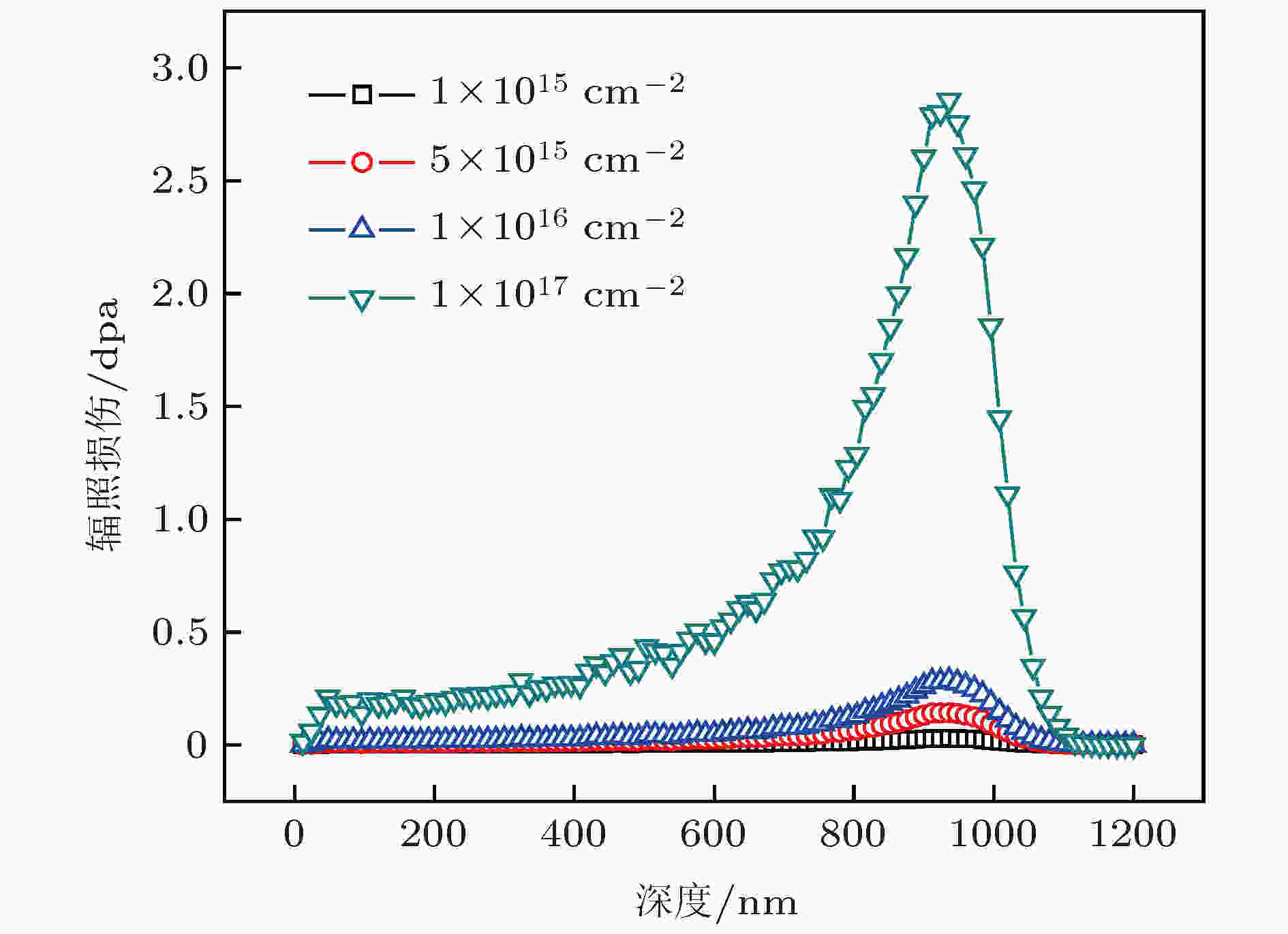
2019, 68 (12): 128102.
doi: 10.7498/aps.68.20190371
Abstract +
Nuclear grade graphite is a kind of key material in the high temperature gas-cooled reactor pebble-bed module (HTR-PM), where nuclear grade graphite acts as the fuel element matrix material, structural material and neutron reflector. In the reactor, the service environment of nuclear grade graphite suffers high temperature and strong neutron radiation. Both neutron radiation and the oxidation by the oxidizing impurities in HTGR coolant can cause the structure to damage and the properties to deteriorate. Therefore, it is of great significance to study the evolution of defects in nuclear grade graphite for improving the reactor safety. The effects of ion irradiation and oxidation on the point defects in IG-110 graphite are studied in this work. The 190 keV He+ implantation treatments at room temperature with fluences of 1 × 1015, 5 × 1015, 1 × 1016 and 1 × 1017 cm–2 are performed to induce 0.029, 0.14, 0.29 and 2.9 displacements per atom respectively. Oxidation treatments are performed at 850 ℃ for 10, 15, 20 and 25 min. Different sequences of He+ ion irradiation and oxidation are performed, which include irradiation only (Irr.), oxidation only (Ox.), irradiation followed by oxidation (Irr.-Ox.), and oxidation followed by irradiation (Ox.-Irr.). Raman spectrum shows that with the increase of ion irradiation dose, the intensity ratio of D peak to G peak (ID/IG) first increases and then decreases, implying that the point defects in graphite are induced by ion irradiation and the point defects evolve as dose increases; the degree of graphitization increases after oxidation, implying that the point defects are recovered by the annealing effect at high temperature, and the point defects decrease after oxidation. This makes Ox.-Irr. samples have a lower point defect content than Irr. samples, and leads Irr.-Ox. samples to possess a higher point defect content than Ox. samples. The positron annihilation Doppler broadening tests reveal that there are only point defects after ion irradiation and oxidation have partially recovered point defects. The ion irradiation and oxidation have opposite effects on the evolution of point defect in graphite. The ion irradiation increases the average S-parameter and reduces the average W-parameter, while oxidation reduces the average S-parameter and increases the average W-parameter. The annealing effect at 850 ℃ cannot completely recover the point defects in Irr.-Ox. samples.

2019, 68 (12): 128103.
doi: 10.7498/aps.68.20190258
Abstract +
Organometal halide perovskites featuring solution-processable characteristics, high photoluminescence quantum yield (PLQY), and color purity, are an emerging class of semiconductor with considerable potential applications in optoelectronic devices. Electron injection layer is an important component of perovskite light-emitting device, which determines the growth of perovskite film directly. In this paper, the perovskite light-emitting diodes (PeLEDs) based on n-type nanocrystalline silicon oxide (n-nc-SiOx:H) electron injection layer are designed and realized. This novel electron injecting material is prepared by the plasma enhanced chemical vapor deposition (PECVD), and its smooth surface and matched energy band result in superior perovskite crystallinity and low electron injection barrier from the electron injecting layer to the emissive layer, respectively. However, the external quantum efficiency (EQE) of PeLED is as low as 0.43%, which relates to defects and leakage current due to the incomplete surface coverage of perovskite film. The fast exciton emission decay (< 10 ns) stems from strong non-radiative energy transfer to the trap states, and represents a big challenge in fabricating high-efficiency PeLEDs. In order to obtain desirable perovskite film morphology, an excessive proportion of methylammonium bromide (MABr) is incorporated into the perovskite solution, and a volume of benzylamine (PMA) is added into the chlorobenzene antisolvent. The perovskite films suffer low PLQY and short PL lifetime if only MABr or PMA is introduced. When the molar ratio of MABr is higher than 60%, the luminescence quenching arising from Joule heating is depressed by employing PMA, contributing to a higher PLQY (> 30%) and a longer carrier lifetime. The synergistic effect of MABr and PMA increase the coverage and reduce the trap density of perovskite film, inhibit the luminescence quenching in the annealing process, and thus facilitating the perovskite film with higher quality. Finally, the n-i-p PeLED exhibits green-light emission with a maximum current efficiency of 7.93 cd·A-1 and a maximum EQE up to 2.13% is obtained. These facts provide a novel electron injecting material and a feasible process for implementing the PeLEDs. With further optimizing the perovskite layer and device configuration, the performance of n-i-p type PeLEDs will be improved significantly on the basis of this electron injection material.
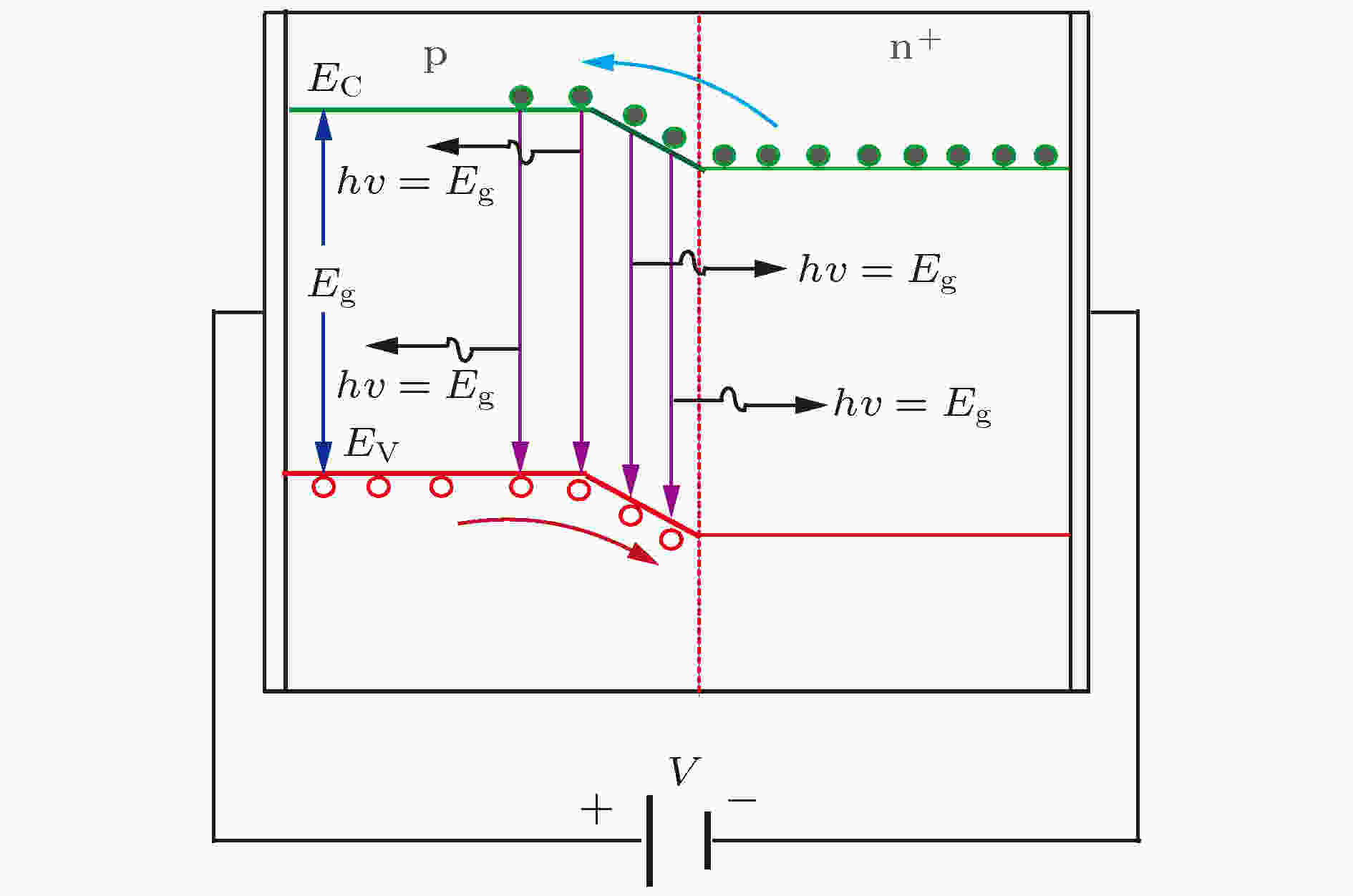
2019, 68 (12): 128104.
doi: 10.7498/aps.68.20190189
Abstract +
During the past two decades, GaN-based light-emitting diode has been used as a high-quality light-source. Low-frequency noise as a diagnostic tool for quality control and reliability estimation has been widely accepted and used for semiconductor devices. Understanding the origin of efficiency-droop effect is key to developing the ultimate solid-state light source. Various mechanisms that may cause this effect have been suggested, including carriers’ escape, loses due to dislocations, and the Auger effect. In this study, we investigate the low-frequency noise behaviors of GaN-based blue light-emitting diode with InGaN/GaN multiple quantum wells. The measured currents range from 0.1 mA to 180 mA. According to the characteristics of power spectral density of current noise and the generation-combination mechanism between electrons and holes in the active region of light-emitting diode (LED), we adopt the well-known model of low-frequency noise to fit the relationship between power spectral density of current and frequency, and find that there exists a transition between generation-combination and 1/f noise when the light-emitting diode begins to work. In other words, it can be derived that the low-frequency noise behaviors are dominated by generation-combination noise when the currents are between 0.1 mA and 27 mA; with the current gradually increasing, the origin source of low-frequency noise in blue/violet-light LED will transit to the 1/f noise. Through the analysis of the transport and recombination mechanism of the carriers, and combination with the model of low-frequency noise, we analyze the corner frequency of the generation-recombination noise. The results of this paper provide an effective tool and method to study the conversion of light-emitting diodes.
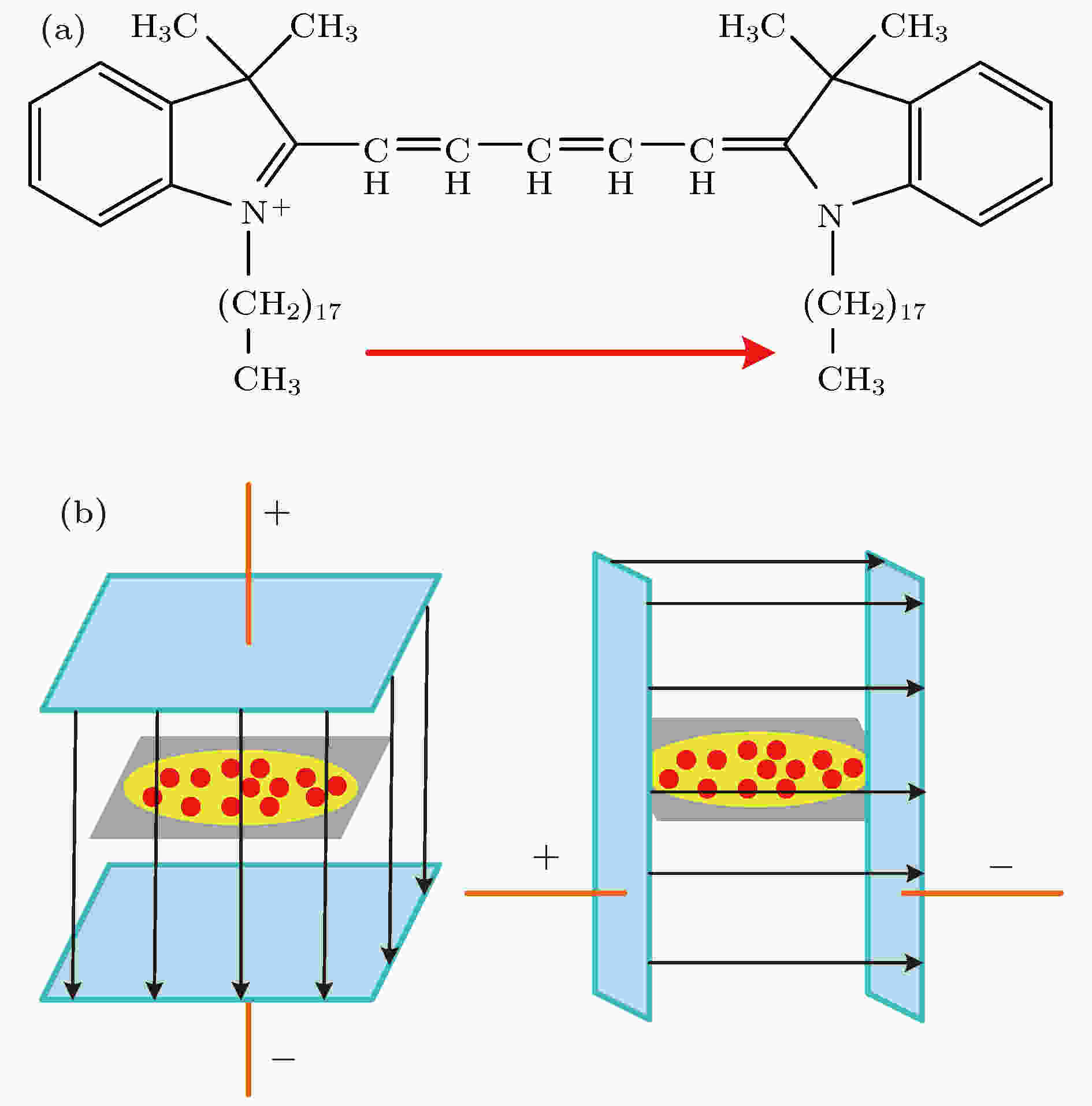
2019, 68 (12): 128201.
doi: 10.7498/aps.68.20190361
Abstract +
The dipole orientation of single-molecule plays an important role in improving the fluorescence collection efficiency and promises to have applications in super-resolution imaging, protein folding, and Förster resonance energy transfer between fluorophores. However, these applications are realized usually by precisely manipulating the orientation of the dipole moment of single molecules. Here, the dipole orientation of 1,1′-dioctadecyl-3,3,3′,3′,-tetramethylindodicarbocyanine (DiD) single molecules with the permanent dipole moment of 14.9 D is manipulated by using an external electric field of 3500 V/mm. Single DiD molecules are prepared by using mixed solvent of chloroform and dimethyl sulfoxide. The dipole orientation of single molecules is manipulated by an external electric field during the evaporation of solvent. The fluorescence of single molecules is measured by splitting the fluorescence collected by an objective into the S-polarized and P-polarized beams, and the fluorescence polarization of single molecules can be calculated by measuring the intensities of two orthogonal channels (IS and IP). The distribution of dipole orientation angle (α) for single DiD molecules in poly-(methyl methacrylate) (PMMA) film is analyzed statistically, and its changes are compared under different electric fields. It is found that the dipole orientation angle α of single DiD molecules in the PMMA film without applying electric field obeys a single-peak Gaussian distribution with the most probable value of 41°, which results from the fluorescence dichroism signal of the high numerical aperture objective. Applying a perpendicular electric field to the surface of single-molecule sample, the distribution of dipole orientation angle α of single DiD molecules can be still fitted by a single-peak Gaussian function with the most probable value of 44.2°. The dipole orientation of single DiD molecules under the perpendicular electric field changes little. However, by applying a parallel electric field to the surface of single-molecule sample, the dipole orientation angle α of single DiD molecules changes prominently. It obeys a two-peak Gaussian distribution with the most probable values of ~ 32° and 55.5°, indicating that the orientation polarization of the dipole moment occurs to the single DiD molecules in PMMA film. The dipole orientation of single polar molecules tends to the parallel electric field in this case.
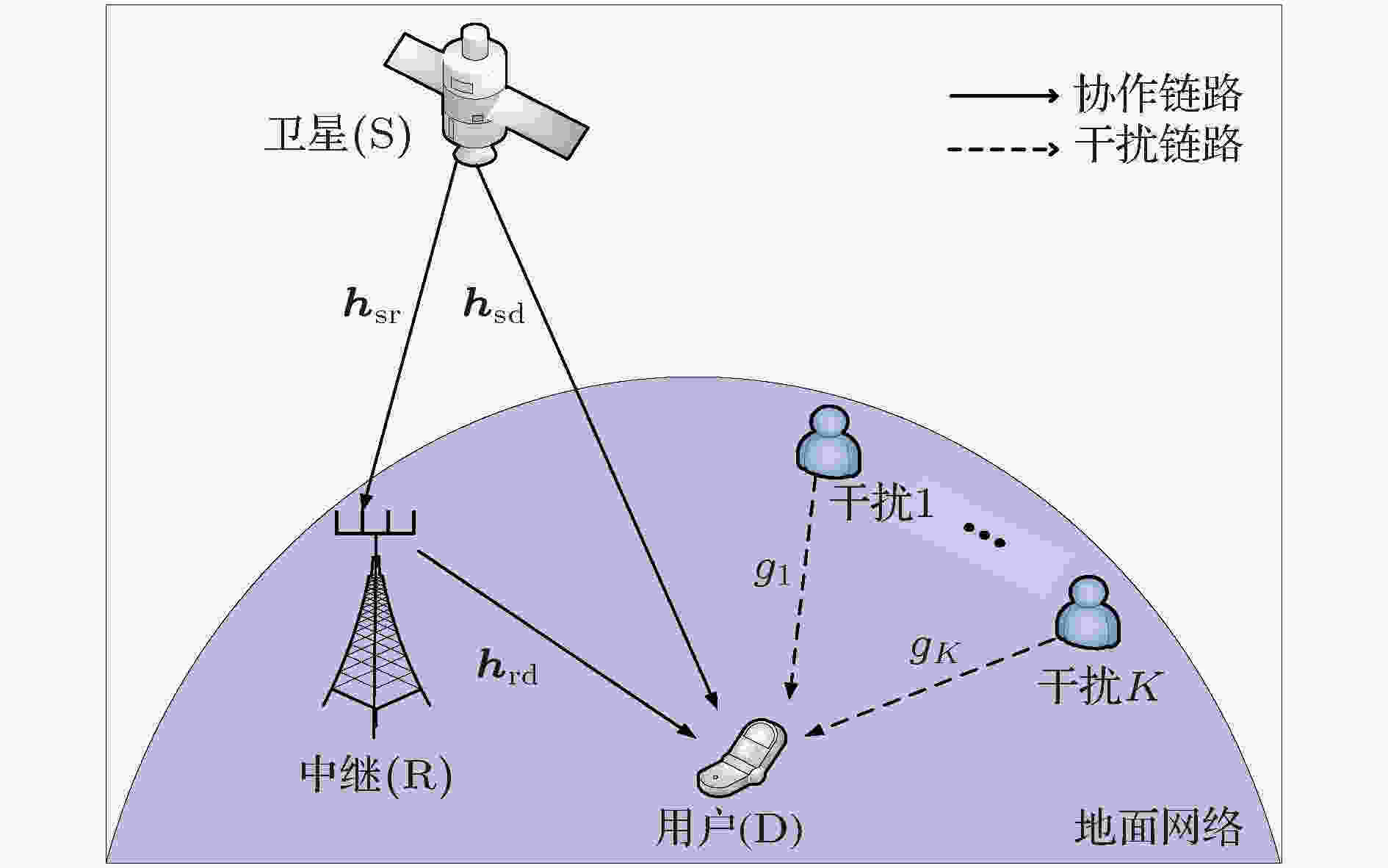
2019, 68 (12): 128401.
doi: 10.7498/aps.68.20190123
Abstract +
As an indispensable method of constructing ubiquitous communication network, satellite communication technology has received significant attention in both industrial and academic areas recently. In this paper we investigate the performance of an integrated satellite-terrestrial cooperative network in the presence of co-channel interference, which consists of a satellite source having a single antenna, a terrestrial relay equipped with multiple antennas to assist satellite signal transmission, and a single-antenna user corrupted by multiple co-channel interference. On the assumption that the user receives the signals from direct link and relaying link with decode-and-forward protocol, the output signal-to-interference-plus-noise ratio of the user with the maximal ratio combining scheme is firstly obtained. Then, according to the Meijer-G function, we derive the moment generating function of the destination and the relay, where the satellite links are assumed to experience Shadowing-Rician fading while the terrestrial links undergo Rayleigh fading, and the analytical average symbol error rate expression for the considered system is obtained. Finally, the simulation results demonstrate the effectiveness of the theoretical analysis and reveal theinfluences of antenna number, interference number, and modulation schemes on the system performance. Therefore, our work provides useful guidelines for the engineers in designing the integrated satellite-terrestrial cooperative networks for future satellite mobile communication.

2019, 68 (12): 128801.
doi: 10.7498/aps.68.20190181
Abstract +
Lithium-oxygen battery possesses an extremely high theoretical energy density ($ \approx$ 3500 W·h·kg–1), and is an ideal next-generation energy storage system. The ideal operation of lithium-oxygen batteries is based on the electrochemical formation (discharge) and decomposition (charge) of lithium peroxide (Li2O2). At the beginning of the discharge, oxygen is reduced on the electrode, forming an oxygen radical (${\rm O}^{-}_{2} $ ). The $ {\rm O}^{-}_{2}$ successively combines with an Li ion, forming the metastable LiO2. The LiO2 may subsequently undergo two different reaction pathways: a chemical disproportionation and a continuous electrochemical reduction, thereby resulting in the formation of Li2O2. Therefore, the oxygen reduction reaction (ORR) is an important step in the discharge process. Studies have shown that graphene is considered as the most promising cathode material for non-aqueous lithium-oxygen batteries. Moreover, it is found that nitrogen-doped graphene has higher electrocatalytic activity than intrinsic graphene for the ORR. However, up to now, the mechanism of improving the ORR for nitrogen-doped graphene is still unclear, and the effects of different N-doping concentrations on the ORR have not been reported. In this work, on the basis of the first-principles calculations, the reduction mechanism of O2 molecule by nitrogen-doped graphene with different N concentrations is studied. Results show that after doping N atoms, the adsorption energy of O2 molecules increases, the O—O bond length is elongated, and the transferred charge increases, which indicates that nitrogen-doped graphene enhances the reduction ability of O2 molecule. Bader charge analysis shows that both N atom and O2 molecule obtain charges from C atom, and N atom also provides charges for O2 molecule, which is consistent with the electronegativity of carbon, nitrogen and oxygen. This charge transfer results in the stronger interaction between the O2 molecule and the substrate, and can reveal the reason why nitrogen-doped graphene can improve the ORR. In addition, it is found that the reduction ability of O2 molecule is best when the N-doping ratio is 3.13 at%. It is hoped that this work will play a guiding role in the synthesizing the nitrogen-doped graphene materials, and will be helpful in optimizing the cathode materials of lithium-oxygen batteries.

2019, 68 (12): 128901.
doi: 10.7498/aps.68.20190087
Abstract +
The measurement of node importance is significant for analyzing a network structure. To comprehensively reflect the global and local network features, in this paper we abstract the propagating process of epidemic diseases based on the network topology structure, and then respectively sets each node as an infection source. After a certain dissemination time K, the number of infected nodes in the network is defined as the K-order propagation number, and the weighted sum of K-order propagation numbers under different values of K is taken as the important index of nodes. The simulation experiments of Watts-Strogatz small-world networks and a dolphin network show that the weighted K-order propagation number algorithm is more effective than the traditional method in evaluating the importance of nodes. For the Watts-Strogatz small-world networks, it can reflect the influence of long-distance connections on information transmission in detail. For the dolphin network, the weighted K-order propagation number algorithm significantly raises the profile of those nodes which play a key role in the information communication between different dolphin communities. In addition, in this paper we use a deliberate attacking method to analyze the western power grid of the United States, the road transportation network of the Chicago region, the co-authorship network in network science and the axonal tracts’ network between neurons of mouse. According to the specific order of the node importance from high to low, network nodes are attacked in turn, that is, all edges of the attacked nodes are removed. The analysis results of network parameters such as the network efficiency and the node number of the maximum sub-graph changing with the attacking times show that comparing with other evaluation indices of node importance such as degree, Ren method, Chen method, eigenvector method, Katz index, PageRank, CI method and K-shell, the weighted K-order propagation number algorithm focuses much on destroying the major structure, and all of the above four networks will break down if only a small number of important nodes are attacked. For example, after attacking only 100 nodes, the network efficiency of the western power grid of the United States is down by 90%, and after attacking 200 nodes, the network scale of the maximum sub-graph is nearly 3% of the original network.
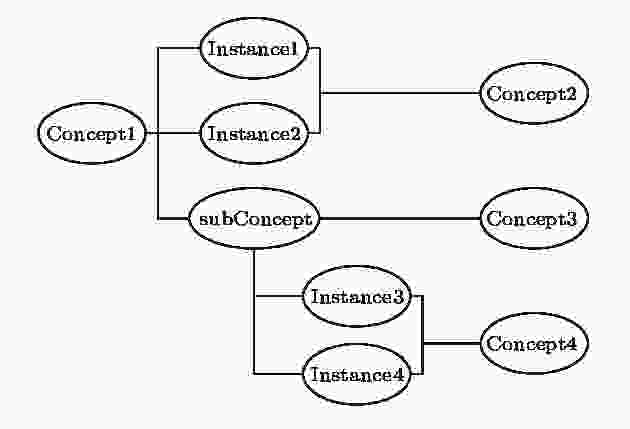
2019, 68 (12): 128902.
doi: 10.7498/aps.68.20190106
Abstract +
Knowledge graph is a hot topic in artificial intelligence area and has been widely adopted in intelligent search and question-and-answer system. Knowledge graph can be regarded as a complex network system and analyzed by complex network theory, which studies the interaction or relationship between various factors and basic characteristics of complex system. Its characteristics and their physical meanings are very helpful in understanding the nature of the knowledge graph. Concept graph is a large-scaled knowledge graph published by Microsoft. In this paper, we construct a huge complex network according to Microsoft’s concept graph. Its complex network characteristics, such as degree distribution, average shortest distance, clustering coefficient and degree correlation, are calculated and analyzed. The concept graph is not a connected network and its scale is very large; an approach is proposed to extract its largest connected subnet. The method has obvious advantages in both time complexity and space complexity. In this paper, we also present a method of calculating the approximate average shortest path of the largest connected subnet. The method estimates the maximum and minimum value of the shortest distance between nodes according to the distance between the central node and the network layer that the node belongs to and the distance between different layers. In order to calculate the clustering coefficient, different methods are introduced for nodes with different degree values and Map/Reduce idea is adopted to reduce the time cost. The experimental results show that the largest subnet of the concept graph is an ultra-small world network with the characteristics of scale-free. The average shortest path length decreases towards 4 with the network size increasing, which can be easily explained by the diamond-shaped network structure. The concept graph is a disassortative network where low degree nodes tend to connect to high degree nodes. The subConcepts account for 99.5% of nodes in the innermost k-core after k-shell decomposition. It shows that the subConcepts play an important role in the connectivity of network. The absence of subConcept affects the complexness of concept graph most, the concept next, and the instance least. The 82% instance nodes and 40% concept nodes of the concept graph each have a degree value of 1. It is believed that compared with the concept words, the instance words do not lead to the ambiguity in the understanding of natural language, caused by polysemy.
GEOPHYSICS, ASTRONOMY, AND ASTROPHYSICS
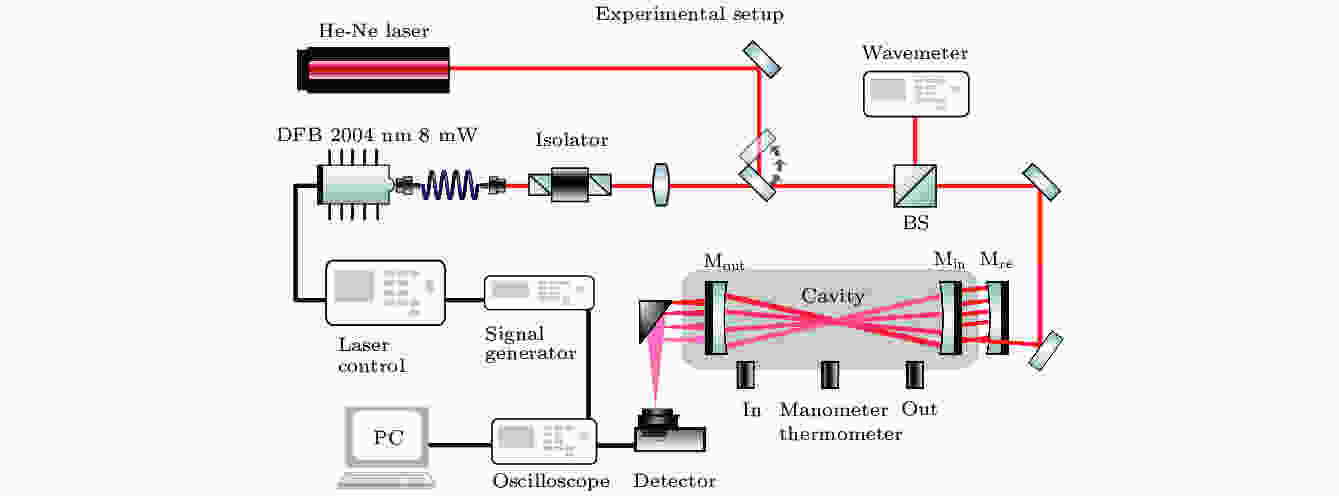
2019, 68 (12): 129201.
doi: 10.7498/aps.68.20190061
Abstract +
Off-axis integrated cavity output spectroscopy (OA-ICOS) is a highly sensitive laser spectroscopy technique. However, due to the use of dense high-order modes for detection, OA-ICOS signal power is low, thus making the detection sensitivity highly dependent on the laser power. To this problem, we introduce an optical re-injection method to re-inject the laser back into the optical cavity again, improving the utilization of laser energy and the power of signal. In this paper, we use optical tracking software to design a re-injection structure, and study several factors affecting the signal gain. Then, we build a re-injection OA-ICOS device in the 2 μm band and also conduct a series of experimental researches. Our results show that the re-injection method enhances the OA-ICOS signal power 8 times and signal-to-noise ratio 4.6 times, which effectively improves the detection sensitivity and the absorption depth of the spectral signal, and alleviates the problem of low signal power in OA-ICOS detection.















